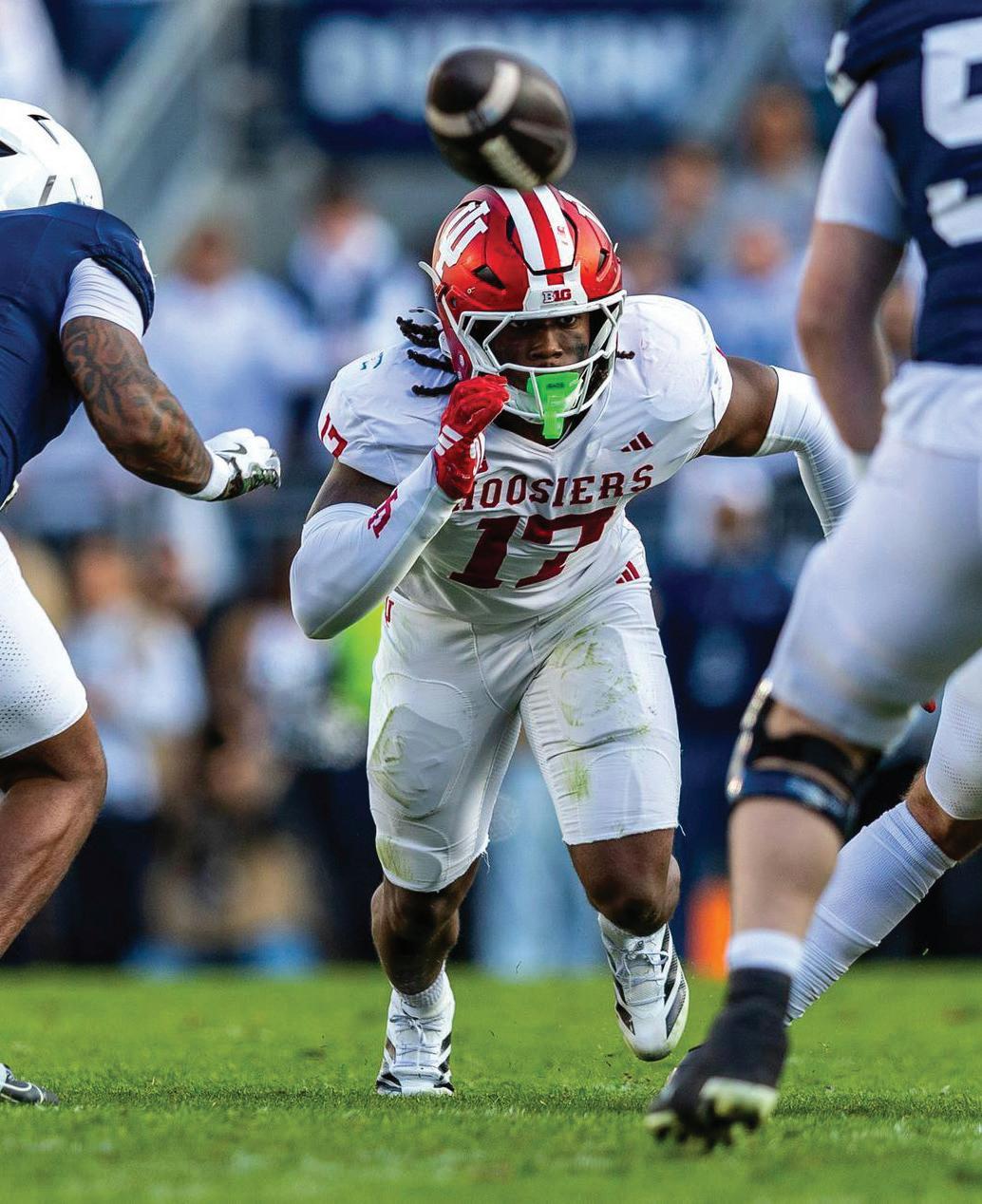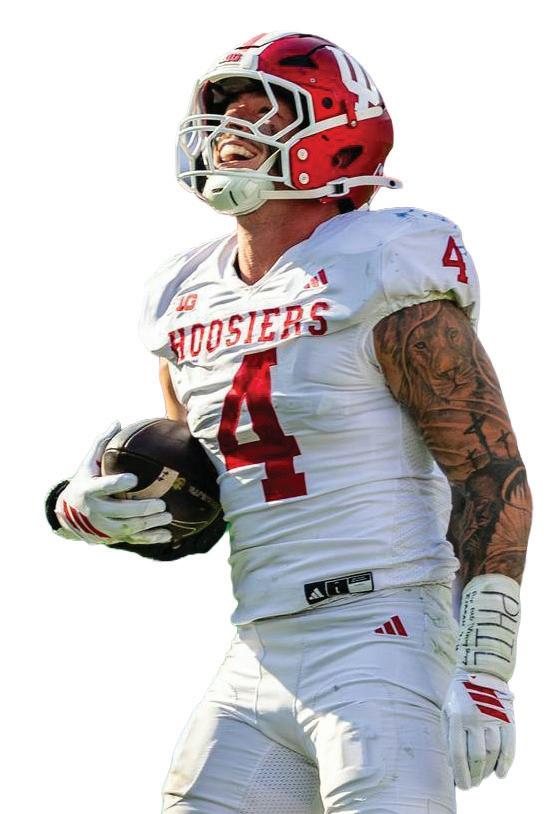James Watson dead at 97
By Samantha Camire scamire@iu.edu
James D. Watson, an Indiana University alumnus and co-discoverer of the structure of DNA, died Nov. 6 in a hospice center in East Northport, New York. His death was confirmed by his son, Duncan Watson. Watson discovered the double helix structure of DNA with collaborator Francis Crick and using the work of Rosalind Franklin in 1953 when he was just 25 years old. The discovery opened the door to modern developments like genetically modified crops and research on genetic mutations, and won the men the Nobel Prize in Medicine or Physiology in 1962.
After a long career continuing to study microbiology and leading major genetics projects, Watson came under fire for racist and sexist comments.
In an interview with London’s The Sunday Times in 2007, he suggested that Black people were not as intelligent as white people. He doubled down on the comments in oncamera interviews for a PBS documentary. He was dismissed as chancellor of Cold Spring Laboratory following the comment and somewhat shunned from scientific circles, for which he harbored great resentment. Over the years, he was also quoted as making controversial comments about gay people, women and people who are overweight.
Watson came to IU for graduate study in 1947. He completed his doctoral thesis in 1950. While at IU, he studied under two fellow Nobel Prize winners, Hermann J. Muller and Salvador E. Luria.
After studying at IU, Watson moved to the Cavendish Laboratory at the University of Cambridge in England. There, he met Crick, and the two teamed up to construct a physical model of DNA.
Their breakthrough came when a fellow researcher gave them access to X-ray images taken by Franklin.
One, Photo 51, provided crucial information about the molecule’s structure.
However, the photo was obtained without Franklin’s knowledge, which goes against standard research protocol. For years, Franklin was left uncredited for her role in the discovery, although today she would have been considered a coauthor in the breakthrough research paper.
Watson cemented his status as a major scientific figure through his leadership of the Human Genome Project and publication of the celebrated memoir “The Double Helix.” The Library of Congress listed the book as one of the 88 greatest in American history, and The New York Times hailed the sequencing of the human genome, an effort he led, as “one of the biggest and most significant international scientific efforts ever completed.” Outside of his more famous endeavors, Watson served as director of Cold Spring and taught at Harvard University. There, Watson mentored undergraduate students, wrote a series of notable microbiology textbooks that remain widely used in biology classrooms today and even offended some colleagues with his dismissal of their scientific fields as lesser than his own.
In his 25 years as director of Cold Spring, Watson transformed the small Long Island lab into a center of microbiology research. After

The school choice dilemma
By Adelyn Rabbitt adrabb@iu.edu
Indiana’s school choice scholarship program, created in 2011 to give lowincome families access to nonpublic education, has become available for nearly all Hoosier families, no matter their income.
The program has contributed to lowered enrollment at the Monroe County Community School Corporation as the program has become more inclusive.
Since June 2023, school choice scholarship recipients have been required to check three boxes:
Be legal residents of Indiana
• Be between 5 and 22 years old by Oct. 1 of the school year to which the student’s scholarship applies
• Have an annual household income that is 400% or less of the income that qualifies students for free and reduced-price lunch, which is around $197,210 for a household of three during the 202526 academic year
Beginning July 2026, the program's income rule will be removed, and the scholarship will become available for all Hoosier students who fulfill the first two requirements, no matter their household income.
“There’s been a push in Indiana and other places to let parents choose schools that fit their (child’s) learning styles the most,” Christopher Lubienski, professor of education policy at IU, said. “In some cases that works, but in other cases, parents don’t necessarily know what’s the best option.”
In the 2024-25 academic year, about $497.2 million in taxpayer dollars were used for choice scholarships statewide, a 13.2% increase from the previous academic year.
From 2021-24, MCCSC saw a 41% decrease in students who live in the district attending MCCSC schools. In the same period, the number of MCCSCdistricted students who chose to attend nonpublic schools using the choice scholarship program increased by 111%.
“This decline in MCCSC
By Kendall Geller kmgeller@iu.edu
At 7:10 a.m. Nov. 9, students in rainbow tiedyed shirts, decked out in glitter, tutus, neon-colored wigs and ribbon took their places on the stage and against the walls of the IU Tennis Center, waiting for their cue.
They burst into motion all at once as a mashup of pop songs blasted from the speakers. For 12 minutes, they moved in sync, performing the dance they’d been rehearsing for months. Hundreds of people gathered in the center of the room, some standing, some singing, some dancing along. Others sat and lay on the floor, blankets wrapped around them while they leaned on their friends with half-opened eyes. Weak cheers rang from the crowd, tinged with excitement despite their rasp after hours of use.
It was hour 35 of the annual IU Dance Marathon, and the dancers from IUDM’s morale committee fought to bring enough energy to the room to keep hundreds of participants awake long enough for the final reveal.
Forty-five minutes later, they were on their feet, anticipation having replaced

student enrollment has a direct impact on the school corporation’s revenue because public schools receive state funding based on the number of students enrolled,” Sarah DeWeese, MCCSC’s director of strategic communications, said in an email. “When enrollment decreases, so does the amount of state funding.”
According to the 2024-25 Indiana Choice Scholarship Program Annual Report, 580 students living in the MCCSC district used choice scholarships to attend schools outside of MCCSC in 2024, which cost a total of over $3.6 million.
Of choice scholarship recipients statewide in the 2024-25 academic year, 47.19% had an annual household income of more than $100,000. This is up from 3.67% in the 2011-12 academic year, the first year choice scholarships were available in Indiana.
Lubienski, who is also a co-author of “The Public School Advantage: Why Public Schools Outperform Private Schools,” said his studies have shown that when controlling for demographic factors and simply testing school effectiveness, students who attend public schools outperform those who attend private schools.
Though the test scores of private school students are generally higher than
exhaustion. The crowd chanted, “Kids can’t wait,” and held up their phones to record the 15 people lined up on stage. Members of IUDM’s accounting committee flipped over blank posters one by one, slowly revealing this year’s marathon fundraising total. Finally, they showed the full amount: $3,135,391.23.
This surpassed last year’s total by over $77,000.
IUDM is a 36-hour dance event that takes place at IU every fall to raise money for Riley Hospital for Children, a pediatric acute care facility in Indianapolis. This year’s marathon started at 8 p.m. Nov. 7 and lasted until 8 a.m. Nov. 9, following the reveal. Thousands of students stayed at the IU Tennis Center during the event. Besides dancing, the marathon included activities such as crafts and games with “Riley buddies,” guest speakers and 5 a.m. yoga on Nov. 9.
IU students founded IUDM in 1991 to memorialize Ryan White, an Indiana high school student who contracted AIDS from a blood transfusion at 13-years-old. When his diagnosis became public, Ryan was barred from returning to school and faced a multitude of discrimination from his
those of public school students, the wealth and parental education factors that private school students generally benefit from give them a step up, Lubienski said.
When such situational factors are reduced, public school students have better scores. Public schools take kids who start out further behind, Lubienski said, and teach them more than they would learn in private schools.
“It’s like having a higher death rate in an emergency room than in a dentist office,” Lubienski said.
He said the better academic performance of public schools is partially because they are held to consistent licensure standards by the state, whereas private schools have more autonomy and can end up hiring teachers who are less trained in their areas of teaching.
Public schools also often have a broader set of course options and extracurriculars, Lubienski said, while also serving a more diverse population in comparison to nonpublic schools. He said private schools tend to have a less standard curriculum as opposed to public schools who adhere to stricter state guidelines.
“From the perspective of current policy, that’s a huge insight,” Lubienski said. “It means that all this money we’re spending on vouchers
and charter schools and education savings accounts in Indiana, it’s not very well spent.”
On the other hand, James McNeany, executive director of the Indiana Non-Public Education Association, said he has heard many stories about the school choice program having a “profound impact” on parents and students. Giving students the opportunity to attend a school that feels like the “right fit” can make students enjoy school more and, at times, perform better, McNeany said.
“We never ever advocate to take money away from public schools,” McNeany said. “I also think it’s extremely healthy when the family takes a look at educational choices and says ‘this is the environment that I’d like for my child to be educated in,’ and I appreciate that in Indiana, we give parents that freedom.”
But Cathy FuentesRohwer, president of the Indiana Coalition for Public Education, said school choice does take money away from public schools. She said it converts money that could be used by public schools into funding for people, including wealthy people, to subsidize their children’s private education costs. She said the money for public schools and private schools comes from the same pot.
“Basically, Elon Musk
could move to Indiana and all 14 of his children would qualify for a subsidy for their private school tuition,” Fuentes-Rohwer said. Public education is important, Fuentes-Rohwer said, because it is where kids come together and learn with kids who are different from them in background, belief and more. She noted that in rural areas, public schools can be a top employer.
MCCSC has about 1,500 employees, according to its homepage.
Lubienski said that while school choice makes schooling seem more equitable, it only accounts for the financial part of the bigger picture. Parents who have the ability to take time off work have more time to research schooling options for their children or provide their children with transportation.
Children with parents who don’t have that ability may have just as much trouble attending certain private schools as they would if they didn’t have a choice scholarship, Lubienski said. Private schools can also carefully choose who they admit, furthering the segregation of students as compared to public schools who generally serve all. While choice scholarships may seem like a nice opportunity for wealthy families, Lubienski said, less fortunate families are often
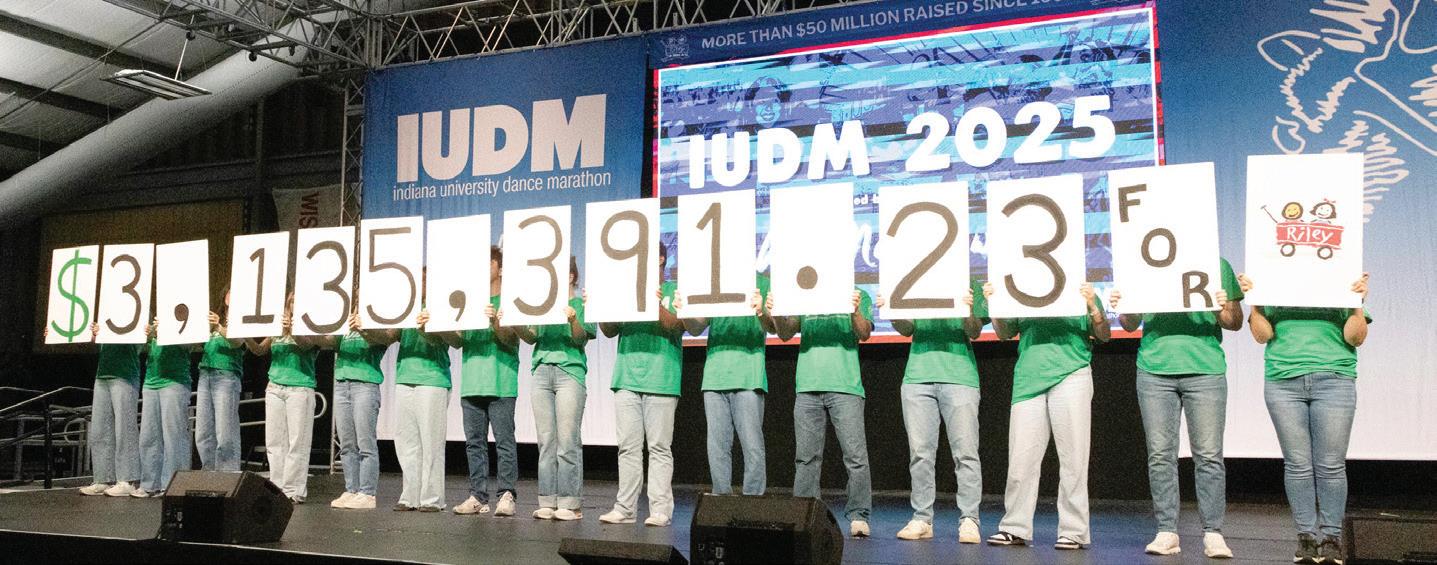
misinformed community. Ryan dedicated his life to advocating for the awareness of the disease before he died in the spring of 1990, just before he was supposed to graduate high school and go on to attend IU.
Since its conception, IUDM has raised over $59 million for Riley and is the second-largest student-run philanthropy organization in the country.
IUDM fully funds three separate endowments at Riley to support the Ryan White Center for Pediatric Infectious Disease and Global Health. The center is part of the Department of Pediatrics at IU School of Medicine and supports research, education and inpatient and outpatient services
for pediatric infectious diseases. The Ryan White Chair in Infectious Disease Endowment and the Ryan White Infectious Disease Endowment support clinical work and research at the center. The Indiana University Dance Marathon Research Endowment guarantees permanent funding for the center.
Today, 75% of IUDM’s donations support research at Riley’s Wells Center for Pediatric Research, while 25% goes toward clinical care. Marathon participants raise money individually, and each committee sets a fundraising goal based on individual member donations.
While students are expected to remain awake for most of the marathon, a lineup of live music, games
and a talent show is aimed at keeping spirits high. Plus, the IUDM morale committee is tasked with bringing the energy up. They performed their 12-minute line dance sporadically throughout the marathon. “The vibes and the energy literally start at 8:01 and it carries you through the marathon,” IU junior and morale committee member Maggie Steward said. “Yes, people are tired and their feet hurt, but you wouldn’t be able to tell, and that’s why I think it’s so special.” The morale committee is one of 18 committees collectively totaling over 1,200 members that meet year-round to ensure the marathon’s success. Each committee falls under one of four main categories:
IU lecturer says she was removed from classroom
By Ian Collier icollier@iu.edu
Jessica Adams, a lecturer in the IU School of Social Work, said she was removed from teaching her class following an intellectual diversity complaint about a lesson where she mentioned white supremacy.
Senate Enrolled Act 202 allows students to report professors who they believe aren’t fostering free inquiry, expression and intellectual diversity.
Adams explained the situation at an American Association for University Professors press conference Nov. 7. She said the complaint was first brought by the student after Adams taught a lesson in her Diversity, Human Rights and Social Justice class that mentioned white supremacy to the office of Sen. Jim Banks, R-Ind. He then took the complaint to the dean of the IU School of Social Work, Kalea Benner, who met with Adams about the issue.
Jessica Adams said a student made a complaint about a lesson on white supremacy
Adams said she felt the complaint was without merit, as she was teaching within the structure of her class.
“I was asked to teach on structural racism, and as you teach on structural racism in the United States, you cannot not discuss white supremacy, as it is the ideology that emboldens racist behavior,” Adams said.
The complaint was specifically about a graphic known as the pyramid of white supremacy, which aims to educate on the overt and covert dimensions of white supremacy. One layer of the pyramid contained phrases like “Make America Great Again” and “Columbus Day” as forms of white supremacy.
Adams said the initial complaint from the student contested that Adams had “verbalized and said that ‘Make America Great Again’ is worse than police violence, and that celebrating Columbus Day is racist and socially unacceptable.”
She said she initially
thought the meeting would informally address the complaint, so she was surprised when evidence was gathered during the meeting she said was later used against her. When Benner reviewed the situation, Adams said she expected support, but instead, she said, Benner became the “primary complainant” on the issue.
Benner did not respond to a request for comment. IU spokesperson Mark Bode told the Indiana Daily Student in an email that IU does not comment on personnel matters.
Adams spoke about her experience alongside two of her students, Zach Harrison and Chelsea Adye Villatoro, who vouched for how Adams’ removal negatively affected their experience in the class, as they were unaware if Adams would return or how their work they turned in to Adams would be graded.
Adams said the guidelines for handling SEA 202 complaints outlined by the IU School of Social Work
were ignored, as she wasn’t given an opportunity for informal resolution. She said she wasn’t allowed and was “vaguely threatened” that bringing counsel for an investigation meeting would lead to it being canceled altogether. Adams never received an explanation as to why she was denied counsel during the investigation meeting.
During the investigation, Adams said she believed that Benner felt she was teaching lessons that weren’t evidence-based and widely used in social work education. Adams refuted this point at the press conference, adding that the lesson was used by the National Equity Project and the National Education Association, and she should have the academic freedom to introduce new lessons to her class.
“I feel that the assumption that it is not evidencebased is rooted in white supremacist ideology,” Adams said. “I feel like it’s very much rooted in the assump-
tion that the experiences and the voices of minoritized populations, individuals, communities are not valid. And so I feel like white supremacy is actually on full display in the way that my case has been handled.”
Harrison finished the meeting in defense of Adams, saying IU administration has displayed a lack of transparency.
On Sept. 29, Villatoro said, there was no formal lecture, and she said the next week she knew something was wrong when on Oct. 6 the class had a guest lecturer instead of Adams.
Harrison and Villatoro both spoke extensively on how the confusion around Adam’s removal negatively affected their experience in the class, including a weeklong period from Oct. 7 to Oct. 13 in which no information on Adams’ removal or future plans for the class were provided to students.
Harrison said that members of the School of Social Work had meetings with Benner to discuss Adams, and although the dean had spoken about having an open dialogue, no resolution was met.
“She, at multiple times during the meeting, questioned the integrity of Jessica, the integrity of the students of this course, and the integrity of the AAUP at IU Bloomington,” Harrison said.
Another IU professor, Benjamin Robinson, was put under investigation for allegedly violating SEA 202 in October of last year.
“I feel that I have not been treated with care or allowed due process, and I do feel that my students are suffering and their education has been compromised,” Adams said. “As I have been removed from their classroom for going on six weeks now.”
“I’m left asking myself, ‘How are we expected to focus when our house is on fire?’” Villatoro said. “This is why I’m speaking. In a profession built on advocacy, silence is complicity.”
Ellettsville to explore merge with Richland Township
By Madelyn Hanes mrhanes@iu.edu
The Town of Ellettsville and Richland Township may soon take steps to become a single government entity.
The Ellettsville Town Council unanimously approved a proposal to explore a potential reorganization with Richland Township during its meeting Nov. 10 night.
Town Manager Mike Farmer said the move would streamline first responder services, protect resources and give residents a strong voice in shaping the community’s future. Richland Township currently uses Ellettsville Fire Protection.
Richland Township is one of 11 townships in Monroe
By Ian Collier icollier@iu.edu
County, with Ellettsville making up a substantial part of its population.
Town Council President Scott Oldham said the plan is not an annexation, a process to increase cities and towns’ jurisdictional authority and claim control over territory of adjacent land, but rather a merger of the two governmental bodies.
If the plan moves forward, a reorganization committee, along with several subcommittees, would look into potential costs, legal processes and the community impact. Any final proposal would go to both the Richland Township Advisory Board and the Ellettsville Town Council for approval before heading to voters in a referendum in
November 2026. If approved, the consolidated government could take effect Jan. 1, 2027.
Farmer said Senate Enrolled Act 1 — a law that restricts local governments’ ability to raise revenue through property taxes — has added pressure on rural townships and towns to operate more efficiently with fewer resources.
During a council meeting in October, Farmer said the town can’t afford to fill a vacant police officer position, which has been open since May, due to SEA 1.
“The proposed reorganization allows Richland Township and Ellettsville to take the lead in shaping their shared future rather than reacting to outside decisions,”
he said.
He added that there is a growing discussion at the state level about possibly limiting township governments altogether. During this year’s budget session, legislators proposed a bill to dissolve townships, but the bill did not pass.
The town is modeling its process after the 2024 consolidation between the Town of Sheridan and Adams Township.
Councilmember William Ellis said the decision is
of the most significant in Ellettsville’s history and urged residents to get involved. Town officials plan to hold a series of public meetings and work sessions in the coming months to gather feedback.

Ellis said.
AAUP, student orgs speak out against IU administration
Members of the Indiana University chapter of the American Association of University Professors denounced the Trump Compact for Academic Excellence in Higher Education during a press conference Nov. 7. In a Nov. 5 press release, the AAUP chapter said the compact demands “institutional neutrality” and calls “for full adherence to its own ideology and threatening to punish those who disagree” by restricting federal funding.
Maria Bucur, an IU professor of East European history and vice president of IU’s AAUP chapter, led the press conference.
“It effectively ends academic freedom and free speech on college campuses,” Bucur said of the compact.
Bucur mentioned that the
Bloomington Faculty Council passed a resolution Nov. 4 urging IU and the IU Board of Trustees to reject the compact.
The resolution urges the university to reject any similar agreement that may make federal funding conditioned on ideology, that grants oversight to federal authorities over matters otherwise governed by professional expertise or any other aspects that might compromise academic freedom or institutional autonomy.
Some also used the press conference to address recent actions by IU’s administration that IU’s chapter of AAUP allege coincided with Trump’s approach to higher education.
On May 22, IU closed the Office of the Vice President for Diversity, Equity and Inclusion, stating it was prioritizing universal access to resources for students and ensuring the university complied with state and federal
laws.
Russell Skiba, a professor emeritus in the IU School of Education and an AAUP executive committee member, said the group denounces the “termination and erasure of diversity, equity and inclusion programs currently occurring at Indiana University.”
IU doctoral student Bryce Greene, representing the IU Divestment Coalition, spoke about how IU placed the Palestine Solidarity Committee on cease and desist in August. Greene helped cofound the PSC while getting his undergraduate degree.
Greene said the PSC has yet to receive an explanation for the cease and desist. He referenced the IU administration’s “massive display of violence” during the proPalestinian encampment in Dunn Meadow last year. Indiana State Police and the IU Police Department arrested Greene and 56 others at the encampment.
Greene also referenced documents verifying that IU, or an entity within the university, held bonds issued by Israel in 2022 and 2023. The university has not provided 2024 holdings. He said that he was angry to see IU holding bonds when there are “entire families being wiped off the map.”
“This is the fight of our lifetime,” Greene said at the end of his speech. “It’s the decision of whether or not we want our university to exist in the future.”
Over the summer, IU announced it would eliminate, suspend or merge almost 250 degree programs to comply with a new Indiana law that requires Indiana higher education institutions to have at least 15 graduates for a bachelor’s degree and 10 graduates for an associate degree.
Ann Campbell, a doctoral student representing the Indiana Graduate Workers Coalition, spoke about The People’s 2030 Plan, designed by
a group of faculty, students and staff at IU. The group identifies IU as a workplace that needs protection from the consolidation of jobs and degrees.
“IU should be managed by this mission, not by the mission of a low labor cost, high margin business,” Campbell said. “We’re not a damn store. We deserve dignity. We deserve support. We deserve diversity, not just in who we are, but in what we study and what we teach, and who deserve collective input.”
The group also discussed Senate Enrolled Act 202, an Indiana law that allows students to report professors who they believe aren’t fostering free inquiry, expression and intellectual diversity. Jessica Adams, a lecturer in the IU School of Social Work, shared during the press conference she was removed from her Diversity, Human Rights and Social Justice class following an
SEA 202 complaint. Omeed Mehrzad, a congressional representative for IU Student Government and executive director of the Indiana Student Government Coalition spoke next. He specified he was speaking for himself and not representing the groups he’s a part of. Mehrzad addressed what he called uncertain and “trying times of rising authoritarianism,” citing IU’s “unattractive boasting of crackdowns” on issues like freedom of speech, tenure and the treatment of graduate workers.
“So now we ask ourselves, what will President Whitten do?” Mehrzad said. “What will the board do? Do we trust them to defend our academic freedom? Do we trust them to protect our faculty, our students and our future? And if they won’t, will we?”
Editor’s note: Bryce Greene is a former opinion columnist for the IDS.
Food security organizations discuss future of hunger
By Elizabeth Schuth ekschuth@iu.edu
Even amid struggle, there’s time for birthday songs. Camaraderie was clear in the group of local food security organizations as they sang “Happy Birthday” to Eddy Riou, South Central Community Action Program’s executive director.
About 20 people gathered at the Monroe County Public Library Nov. 9 to discuss current issues with food aid, problems affecting the Bloomington community and its hopes for the future.
These organizations included Hoosier Hills Food Bank, the Indiana University Student Care and Resource Center, two township trustees, South Central Community Action Program, United Way of South Central Indiana, Mother Hubbard’s Cupboard and People’s Cooperative Market.
The panel was hosted by Bloomington City Councilmembers Isak Asare and Courtney Daily and Monroe County Commissioner Jody Madeira.
“Today is about understanding needs, sharing resources and identifying community-led actions that make our local system stronger,” Daily said. Panel members highlighted their common focus on providing food to the community, describing it as the first step toward solving a multitude of issues.
“Food is paramount,” United Way of South Central Indiana President and CEO Randy Rogers said. “If they go hungry, they’re not going to make wise decisions across the board. So, how do we get them food so that we can start to also relieve all these other challenges?”
Cuts to the Supplemental Nutrition Assistance Program starting Nov. 1 caused
more than 16,000 individuals in six counties served by Hoosier Hills Food Bank to lose benefits. SNAP provides government-issued grocery vouchers to low-income families. Yet, in conversation at the panel, organization representatives made it clear that the number of people in need hasn’t increased dramatically, but the amount of aid needed has.
“People have been going hungry for a long time now,” HHFB Executive Director Julio Alonso said. “Agencies are already stressed and don’t have enough food. Taking away these benefits from people really does push it into crisis levels.”
Jada Bee, co-founder of People’s Cooperative Market, suggested the local government help fund food insecurity efforts by cutting down on the police budget and shifting the extra funds to food banks. The City of Blooming-
ton has responded to recent SNAP cuts by donating $46,000 to HHFB using its emergency funds.
Pantry users face a common struggle of traveling across the city to many different pantries to get the food they need.
“How do we make it so that when people come to me, they get their full market basket?” Mother Hubbard’s Cupboard CEO Megan Betz said. “They’re not doing this bobbing around, spending all of their time when they have jobs where their wages are low and they have no PTO.”
Kristen Lucas, associate director of basic needs in the IU Student Care and Resource Center, highlighted students as a particularly vulnerable population in Bloomington. In 2020, the U.S. Department of Education National Postsecondary Student Aid Study found 23% of undergraduates in

the United States faced food insecurity. IU Dining recognizes 25% of IU students as at risk for food insecurity. Lucas suggested greater collaboration between off-campus organizations and student need. Organizations also emphasized the amount of time spent on fundraising to remain operational. Six of the nine panel members raised their hands when an audience member asked if they spent at least 60% of their time raising money. The panel ended with a call for community involvement, encouraging monetary donations and volunteering.
“Pick your favorite, whether it’s volunteer time, donating food, donating money, do that,” Alonso said.


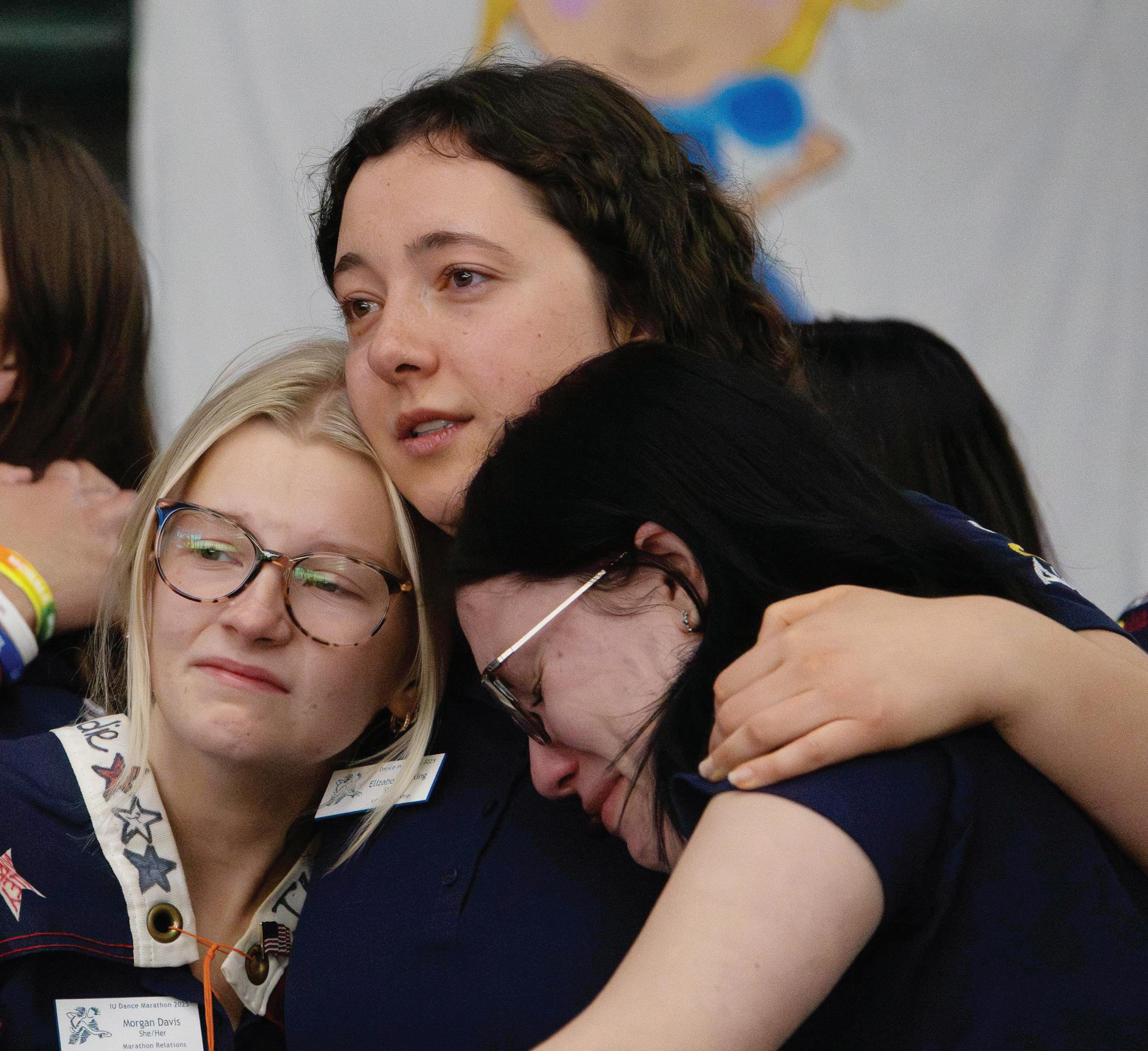

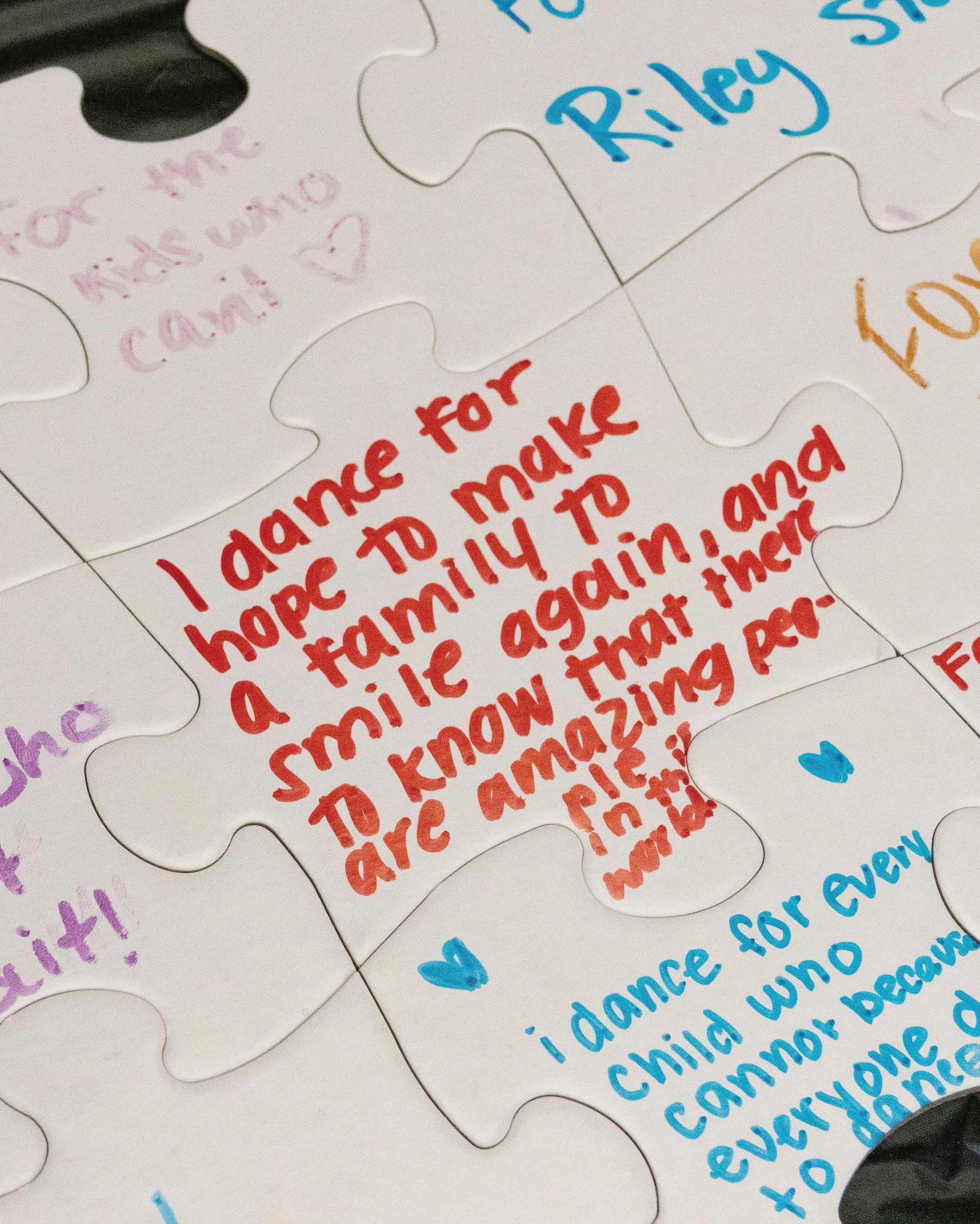
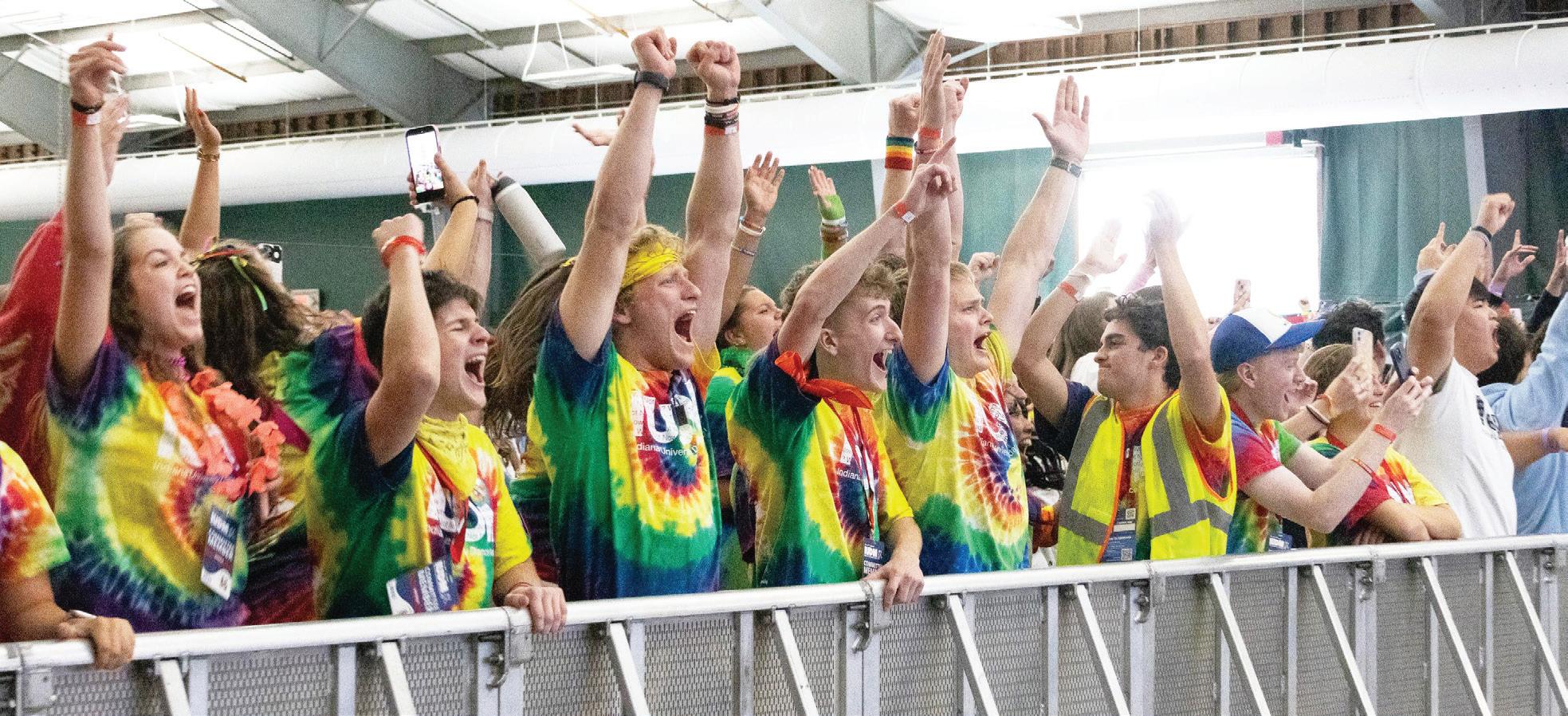
Junior Ella Self is director of the public relations committee, and this was her last marathon before graduating early. Self was a triplet born prematurely and spent the first two months of her life in the neonatal intensive care unit at Riley.
After fundraising for Riley throughout high school, she now helps lead IUDM’s communication efforts.
“I want people to leave
knowing that they're doing something that's not normal for college students,” Self said. “To take so much time out of your life to benefit the welfare of others is so rare, and I want people to remember how special that is.”
During the marathon, guest speakers including former Riley patients and their loved ones came up on stage to share their
experiences. Rose Black told the story of her son, Vincent, on Sunday morning. Vicent’s journey at Riley began when he stopped breathing shortly after birth. He was born with severe disabilities and had about 100 surgeries but lived to be 42. Black said Riley’s care allowed Vincent to live a full life despite challenges, and he always met each day with joy and faith.
Vincent danced in two marathons, one in which he spent all 36 hours in a wheelchair. Black thanked IUDM participants for the work they do to ensure more people like Vincent can live the life they deserve.
Sophomore Nora Flickinger is a member of the marathon relations committee, which works with high school dance marathons across the state to
continue IUDM’s mission.
“Every single drop in the bucket counts,” Flickinger said. “And if you're here for an hour, if you're here for 36, if you raise $10 or $150 million, every single penny counts, and being a part of something greater than yourself will outlast every single little thing you could do.” At 7:30 a.m. Sunday, IUDM President Matt
McCormick gave an address before the total reveal. He commemorated the marathon’s purpose, impact and all the people who helped make it happen.
“In a few moments, the final total will be raised, the music will fade and the Tennis Center will slowly empty out,” McCormick said in his speech. “But what happened here, the memories, the hope, the
How a federal fellowship cut impacts students
By Gabby Rogers rogersgm@iu.edu
Anna McElhannon had been studying physics, a traditionally maledominated field, for seven years when she lost the fellowship meant to fund three years of her education.
McElhannon said physics can be socially ostracizing for gender minorities and women in the field, making fellowships like hers more crucial.
But the U.S. Department of Education discontinued a fellowship supporting six IU physics doctoral students, including McElhannon, from “traditionally underrpresented backgrounds,” only one year into its original three-year duration.
The fellowship, Graduate Assistance in Areas of National Need, provides grants “to support graduate students with excellent academic records who demonstrate financial need to pursue the highest degree available,” according the Federal Register website.
“The students (selected) had to be excellent students
already,” Mike Snow, IU physics professor and principal investigator of the fellowship, said.
As principal investigator, Snow was the “point person,” of the fellowship. He organized the proposal for the award with input from the rest of the physics faculty.
The selection criteria for GAANN also included that the recipients chosen were from traditionally underrpresented backgrounds.
Snow selected women and nonbinary students — groups classified as underrepresented in physics — for the fellowship in accordance with the award criteria from the education department, distributed under the Biden administration.
“We did what the program asked us to do,” Snow said. “Then, a year later, we got this message that said, ‘we changed our minds’ basically.”
One year into the threeyear grant cycle, on Sept. 16, Snow received a letter from the education department saying GAANN’s funding would be canceled starting
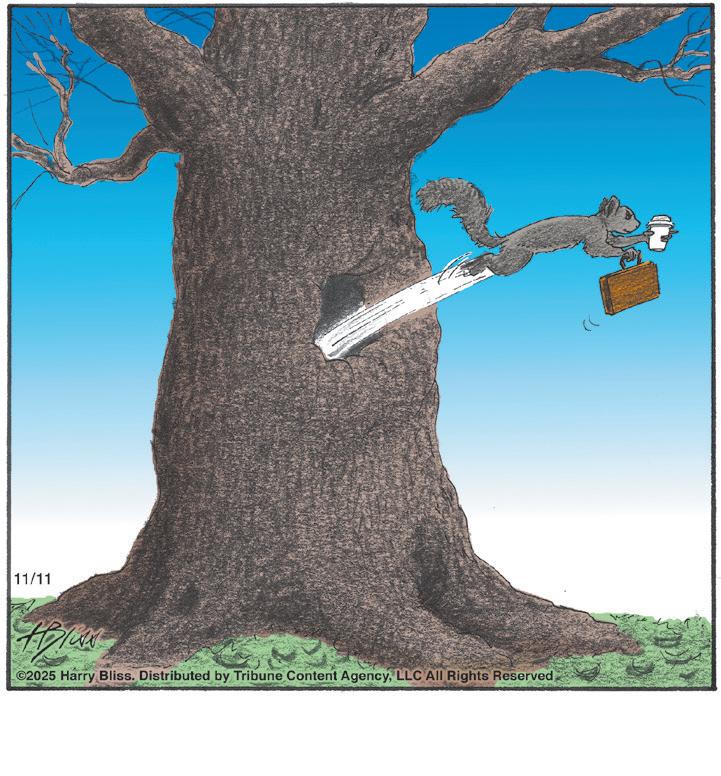
Sept. 30. The letter offered a chance to appeal and seven days to respond. After the physics department consulted with the College of Arts and Sciences, the IU Office for Research Administration sent that appeal Sept. 17. Shortly after the seven-day window, the education department responded, stating that their original decision still stood.
The letter from the education department cited two points on why the fellowship was discontinued. The first was the physics department’s promise to request assistance from the IU Office of the Vice President for Diversity, Equity and Inclusion, and the second was the department’s goal to increase the fraction of graduate students from traditionally underrepresented groups.
The second point made was explicitly listed as one of the goals of the GAANN program by which the proposals of the grant would be evaluated for approval. Now, the education department cites it as a

Publish your comic on this page.
The IDS is accepting applications for student comic strips for the spring 2026 semester. Email five samples and a brief description of your idea to adviser@iu.edu . Submissions will be reviewed and selections will be made by the editor-in-chief.

reason for the termination of the fellowship.
The letter also requested that the physics department pay back the distributed funds that had already been given for beyond Sept. 30.
The next steps, Physics Department Chair Mark Messier said, include clarifying with the education department how the accounts need to be closed, which is currently impossible due to the ongoing government shutdown.
“Priorities change when administrations change, so that’s not unusual,” Messier said. “It’s unusual for an administration to terminate something that's already been approved midstream.”
Snow advises McElhannon, who said having the money yanked out from underneath her has left her life up in the air.
“We had planned our thesis and our research around this fellowship,” McElhannon said. “Now it’s being disrupted by the fact they've taken away this money that they have assured us.”
The main way doctoral
students are supported, Snow said, is through a combination of being associate instructors and support for research from external grants or fellowships. So, having a fellowship like GAANN allows students to devote all their time to research instead of having an obligation to teach.
Some of the graduate students will now have to become associate instructors, which may cause a delay in their degree progress.
McElhannon would’ve opted to become an associate instructor for financial support, but she isn’t sure she can teach while living in Japan. McElhannon received a separate fellowship to live in Japan for two months during the spring 2026 semester to finish her thesis work.
“So, how am I supposed to be able to teach when I’m gone for two months?” McElhannon said. “I don’t know if I have to save up extra thousands of dollars for rent in case I get paid late.”
Going forward, Snow
said, there will be a collective effort among the physics department to figure out how to keep the students making progress toward their degrees. There is no “one size fits all” solution to the problem, he said, but it is a department priority to ensure the students find new sources of support.
“This was a fellowship that supported outstanding students,” Snow said. “The ‘underrepresented groups’ aspect of the fellowship was kind of on top of that. We are fortunate to have a lot of outstanding female PhD thesis students in our physics department who were already kicking ass.” McElhannon said the cut upended the trajectory of people's doctoral degrees, but she’s grateful the department has people she knows will work to make sure the students are okay. “I have faith in my department, and I have faith in my advisor and in Mark Messier, the chair,” McElhannon said. “They’re doing everything that they can. It just sucks that they’ve been put in this situation.”







Ainsley Foster (she/her)
is a senior studying elementary education.
When I got in trouble as a kid, my parents would take away my book. I snuck books everywhere. In class, I always had an open book in my desk that I would slide out of sight if the teacher walked by. At night, I hid a book in my pillowcase, then read by the light of my alarm clock (turning on the lamp would alert my parents).
During car rides, at grocery stores — you name it — I was reading.
Then at 13, I got a phone, and that changed. All of a sudden, screentime interested me much more than anything else going on. I found myself totally addicted and my love for reading slowly but surely faded away, replaced by the incessant need to scroll.
While I would love to say I’ve changed my ways since my adolescence and am now the epitome of a hyperproductive superhuman, that would, unfortunately, be a lie. What drives me crazy is that I know it’s bad for me. I know I feel worse from that guilty feeling of procrastination combined with a screentime induced headache. So, why do I keep wasting my life away?
But self-awareness is key, so I invite you to join me in fighting our phone addictions — with a book or two.
It’s hardly surprising the wealth of academic literature that ties the health of a person’s attention span
Fight your phone addiction — with a book

with “reading tasks” is quite extensive. It doesn’t take a neuroscientist to know I feel like I can’t focus as well with my phone on my desk. The research on this shows significant correlations between children’s visual attention span with “all reading tasks.” Reading has been “proven to increase your focus, attention span, concentration and to improve memory,” researchers at Hawaii Pacific Neuroscience wrote. This year, I realized something had to change. I was tired of my phone con-
trolling my free time, and there were too many good books sitting on my shelf for me never to read them! Third grade me was blowing through at least one book a week, so surely, one book a month for college me would be no big deal. Naively, I made a goal to read 12 books before 2026. I had a rocky start; it wasn’t until March that I finished the first book. Now, I’m doing a little better; so far, I have read eight books and have been working on the ninth since September.
As an (almost) teacher,
one thing I always tell my students before we read a book together is that books are either mirrors or windows, meaning they can help us reflect on our own experiences or provide us with insight into someone else’s — and good books have the opportunity to do both.
When I started reading again, I picked up “The Alchemist” by Paulo Coelho; its a “modern classic” about chasing one’s purpose and how each of our individual journeys toward that purpose are intertwined. I chose
this one, chiefly because I have a niche interest in classic literature, but also because this one is quite a short and easy read. After I finished the book, I gave it to my fiancé, a Purdue Engineering student with very little time, and he found the book very enjoyable too.
If you’re looking for a place to start, check out the Monroe County Library. It’s free! One of my personal favorite places to find a good book is the app Goodreads, which recommends books you might like based on books you have already read.
It’s also a great way to digitally store books you want to read later. I find myself referring to my Goodreads library quite often when I’m looking for what to read next. Our phones make it very easy for our lives to revolve entirely around ourselves. The algorithm tailors content to predict exactly what we will like. We follow and subscribe to the people we choose to listen to. Everything is fully customizable to suit our exact preferences. Books force us to experience life in the shoes of someone else. By reading, we endure the slow build of a plot and pay attention to details that don’t fit neatly into a short video clip. Reading is active, not passive. It asks something of us that our phones never will: focus, patience and curiosity. In return, reading gives something that scrolling never will: a story that isn’t filtered through algorithms or hashtags. When we read, we remember what it’s like to live beyond our own bubble, to think deeply instead of reacting instantly. There’s no clickbait in a book, no ads trying to sell you something, no one vying for your like or follow. Books don’t ask to be liked, they ask to be experienced. Maybe it’s time to slow down, pay attention, and give the world, and ourselves, the focus we’ve been missing.
ainsfost@iu.edu
Writing a book is a mental sport with endless resources
Aryana Amin-Tehrani (she/her) is a senior studying marketing, management and digital and social media business applications.
“The pen is mightier than the sword” may sound cliche, but picture this:
A reflective blade slices through air. Cold, iron-plated metal flashes in the blink of an eye. The sword suddenly sounds more dangerous than this generic idea of the “sword” itself, right? With proper discipline and the initial motivation to begin a new project, writers can take simple words and turn them into meaningful stories.
However, with a seemingly endless list of daily todos, 21-time New York Times bestselling author Jerry Jenkins says it is far easier to quit than to finish. There’s no lack of resources available when it comes to writing a book, but a lack of motivation and discipline gets in the way and is the reason why many stories remain unfinished.
If we wait for motivation to strike and for that creative spark to come to us, we will be waiting forever to pick up our pens again. We may write for an hour or so before leaving our projects dormant for a week. Then, once we revisit our work, we may forget or want to rework pieces of the story, creating a neverending cycle of incomplete projects and unfulfilled discipline.
That’s why, unsurprising-
ly, the most common advice for aspiring writers is simple: just start. Plot the different characters and their personalities along with the climax and layout of the story. I started a novel project over the summer. My aspiring-author friends told me creating the characters would be the most exciting part — and they were right, I found joy in forming the characters as if they were real people with hobbies, interests, favorite colors and personal goals. I worked on the project during the summer but dropped it after I sustained a hand injury. However, I hope to be able to pick up the project again soon. With academics being a commitment, I struggle with the discipline to make time for writing myself. Learning from people who have already succeeded is another useful tool. It would make sense, at least to me, that someone who has already published their stories and projects is likely to have more knowledge on how to approach common challenges such as publishing and outlining.
Cheyenne Betz from Ameredian compiled a list of the best writing apps, both paid and free, for 2025. Stephen King has written a book titled “On Writing” that is a good example of resources in the form of books as well. The book combines his life story, as well as a guide to writing as a craft. Reading books about writing can lead you
to implementing some of the advice into your own writing. You can take an already bestselling author’s advice and weave it into your own current strategies — whatever they may be.
I recently stumbled upon a Reddit post where an anonymous user compiled a comprehensive list of resources for writers including podcasts, websites, blogs, books, places to get your writing critiqued, tips for selfpublishing and more. These resources can help you understand the different pathways to getting your work out in the world. I haven’t tried these tools yet, but it’s something I plan to investigate further once I pick up my project again.
Personally, the most effective and easy-to-follow advice has been John Green’s YouTube video titled “8 Things I Wish I Knew When I was Writing my First Novel.” Green recommends writing 1,000 words a week so you don’t lose connection to your story and so the cycle of forgetting to write doesn’t occur, but he says the recommendation is flexible. I love the idea that Green doesn’t have a schedule for when to write or a specific number of words he writes each day. It allows for a creative flow of work while still maintaining the barriers of regulation. Writing can be challenging; it’s not easy, but implementing tips and tricks like this can help the process. Differ-

ent tips may match different types of work, but in the end as long as Green maintains 1,000 words a week, it seems to be his form of discipline.
Green feels if he doesn’t write 1,000 words a week, he may not write again for months. It’s a cycle many writers face. Without some form of discipline, our dreams of writing cannot come true. I have used this method myself and found it to be very productive. Without a strict schedule, I felt less pressure to maintain a certain amount of progress — even when at the back of my mind, I knew I wanted to write at least 1,000 words that week. I was able to keep this up the entire summer, until an injury to my
hand hindered my progress. Consistency is key. Last week, a friend of mine introduced me to the Pomodoro method: Write for 25 minutes, then take a five minute break. After multiple rounds, take a longer rest. This structure can help maintain focus and limits burnout. For example, you can dedicate the first 25-minute period to reading where you last left off, the next to editing your prior work and the following to adding more writing.
With an abundance of resources to help you write, as well as methods to stay focused, I truly believe anyone can be a writer and eventually an author. As Indiana University students, we have access to writing clubs on
SNAP funding crisis will leave Hoosiers hungry
campus such as Lifewriting Club and Writers Place, that support writing in the form of workshops available right at our fingertips! I’ve attended some Writers Place meetings in the past, and I found it to be very helpful. Club members submitted a portion of a recent story, and other members gave advice and tips on how to improve the story. The club also had writing prompts at the start of meetings, and hosted guest speakers with experience in publishing.
Writing isn’t easy, but with a little discipline and time each week, writing something you’re proud of is possible for everyone.
aaminteh@iu.edu
On Nov. 1, 2025, for the first time in its over 60-year history, 42 million Americans (over 570,000 Hoosiers) did not receive their monthly Supplemental Nutrition Assistance Program benefits, also known as “food stamps.” The current partial funding plan is insufficient and unacceptable in the wealthiest country in the world. We are urging all Hoosiers (especially students, staff and faculty at IU who care about the health of our community) to act now. We can step in to help keep food on our neighbors’ tables and demand more from our elected officials. This issue hits close to home. Bloomington’s working class is being squeezed from all sides. Bloomington officials have called the housing situation a “crisis,”
as about 61% of residents spend over 30% of their income on housing. This leaves little left for other necessities, including food. Here in Monroe County, an estimated 7,697 residents rely on SNAP benefits to put food on the table. Our neighbors, classmates and coworkers face food insecurity every day.
Food insecurity isn’t just about hunger; it carries serious health consequences including increased risk for lead absorption, especially for children. An empty stomach can absorb up to 100% of ingested lead and children with diets lacking in vital minerals and vitamins are at greater risk. Once lead enters the bloodstream, it can cause irreversible organ and brain damage, affecting development
and learning. Every family deserves to have food on the table, and every child deserves the nourishment needed to grow, learn and thrive.
Amidst all of this chaos, the current administration has taken additional steps to try to sweep the issue of hunger in America under the rug. Recently, the USDA canceled its annual Household Food Security report. Without this data, policymakers, researchers and local governments lose a critical tool for identifying who is most affected and whether anti-hunger programs are working. In the absence of this data, hunger becomes easier to ignore.
As we approach Thanksgiving, we urge anyone who calls Indiana home to support food access for all Hoo-
siers and ensure this crisis will not be ignored.
Need assistance? On campus: Crimson Cupboard open Monday through Friday at the Indiana Memorial Union and Campus View Apartments Monroe County: Local food pantries and prepared food sites
• Hoosier Hills Food Bank (333 W. Industrial Park Drive)
• Mother Hubbard’s Cupboard (1100 W. Allen St.)
• Community Kitchen of Monroe County (1515 S. Rogers St.)
Want to help? Here’s what you can do: Donate time or money (this is more effective than donating food) Call your representatives
in Congress and demand that SNAP be funded in full and benefits be distributed immediately. The most effective way to contact Congress is by calling. Short script: My name is [your name] and I am a constituent in your district. I am urging you to use your influence to ensure SNAP is fully funded and distributed immediately to prevent a food security crisis in our community.
Find your federal representatives: https://www. congress.gov/members/ find-your-member Call Indiana representatives and ask them to step in and make up the shortfall in SNAP benefits with state funds.
Short script: My name is [your name] and I am a constituent in your district. I
am urging the Indiana legislature to step in and fill the gap in SNAP funding and prevent Hoosiers from going hungry.
Find your Indiana state representatives: https://iga. in.gov/information/findlegislators No one in America should go hungry. By calling your representatives, volunteering, and speaking up, we can ensure Hoosiers have access to the food they need to be healthy members of our community.
Emory Hoelscher-Hull, School of Public Health, IU –Bloomington Alyson Alde, School of Public Health, IU – Bloomington Allison Holder, College of Arts and Sciences, IU –Bloomington
The Bluebird: How a deli became a music scene
By Stella Klaus ssklaus@iu.edu
Photos line the walls of The Bluebird nightclub, showcasing the many artists who have played at the venue throughout the years.
From John Mayer to Zach Bryan, there is no shortage of big names who’ve performed at the club.
The Bluebird first opened as a bar and deli in 1973. But when bar owner John Ross opened a music venue in the back, the establishment quickly transformed itself into a staple of the Bloomington music scene.
58-year-old David Kubiak, the current owner, officially purchased The Bluebird in 2004 after booking and managing it for several years prior. As an IU alumnus who graduated in 1991 with an economics degree, Kubiak went to the bar and music venue throughout his time at IU.
As the music world has continued to change, The Bluebird has morphed with it, Kubiak said.
Through the years the bar has tried to please crowds by hosting artists or genres who were relevant to the time. One of the biggest challenges, though, is predicting the relevancy of these genres while booking performers.
While popularity of genres changes often, Kubiak said country seems to be one of the most popular currently. Though Kubiak says country music is not the long-term plan for The Bluebird, many country musicians have been touring and playing at The Bluebird in recent years.
As the owner of the establishment, Kubiak also works on scheduling artists to come play and all of the things that go with that including ticket pricing and promotion.

“I’m conscious of trying to get different segments of campus or people that live in town,” Kubiak said. “I want everybody to try to experience The Bluebird at some point so if you are into a certain genre of music, I mean we want to have enough variety that everybody can come experience it.”
The other side of finding artists to perform is thinking about the weekend crowd. With parents and alumni coming to Bloomington often on weekends, for games or other events, Kubiak said he must take that into account when scheduling artists. He wants to bridge the gap between college students and parents, offering music they can both enjoy.
Cover bands are often among the musicians sched-
uled for weekend performances because of their relatability to different generations. However, Kubiak likes to give opportunities to local bands as well, giving them the chance to get their leg in the door of performing. One of these is IU student band Opal, a classic rock band that formed through Bloomington Delta Music Club.
“Opal is a great example of the newest band that’s really starting to get their legs under them, and they’re still improving every time,” Kubiak said. “It’s really exciting to watch really. You’ll see their musicianship grow, their stage presence grow, then they’ll start toying with song selection of ‘this is what’s working and potentially not working’ and they’ll eliminate it. It’s the
confidence on stage and all of that, then you watch their fan base grow at the same time which adds more energy to it.”
Having new campus bands play at the venue helps in two ways. It not only helps to improve the band’s skills, but it helps the bar by bringing more students out to the bar so they can watch their friends.
“It’s definitely been the highlight of my college experience. It’s been so cool, I can’t believe I play there.”
Frances Stemme, Opal Bass Player
Since their first time playing the music venue in November last year, Opal has
continued to grow a presence at The Bluebird.
“Ahnay, our guitarist from the band, it was like right before Thanksgiving break, and he was driving past The Bluebird, it was the first day it was snowing last year, and he saw somebody was there so he was just like, you know what, I’m gonna regret it if I don’t go say hi,” Frances Stemme, Opal’s bass player, said.
After knocking on the door and talking to Kubiak, the owner decided to give them a chance and the band had a gig booked for the very next day. Through their performances at The Bluebird, Opal has found a community within the music world. They’ve also gained a lot more support and have made friends with other
bands and gotten to know the staff.
Stemme has felt inspired by the many bands that have performed at the venue before. Namely Six Foot Blonde, an IU student band that started in Bloomington but has since then grown a larger platform and is playing in bigger cities.
“I think it’s just a really great venue for like younger bands to get the experience that we’ve gotten as performers to build up a fan base, to kind of get their name out there in the community and it’s also just a really great place to go and listen to music,” Stemme said. “It’s definitely been the highlight of my college experience. It’s been so cool, I can’t believe I play there.”
As a large part of the local music scene, The Bluebird offers many opportunities for community members to hear their favorite bands or even discover new ones. For IU senior Morijah Kahl, it’s watching live music — and finding good deals on drinks — that draws her to the bar.
“You can’t beat live music,” she said. One of her favorite bands that she has seen at The Bluebird was Yours Truly, another band that started at IU. Though the members have
for newer artists.”
COLUMN: ‘Frankenstein’ shows what it means to be human
By Steven Leatherwood
sjleathe@iu.edu
While many know the popular depiction of “Frankenstein” from the 1931 Universal Pictures film, my main exposure to the story was when I read the original book by Mary Shelley in high school. After reading such a masterpiece, seeing the monster depicted as a viridian Halloween monster seemed mildly insulting to Shelley’s work.
However, I believe Guillermo del Toro has revived the Shelley story into something truly remarkable with “Frankenstein,” released Nov. 7 on Netflix.
The first 20 minutes immediately captured my attention with its impeccable production design, costuming and score. I was enchanted by the billowing crimson veil of Victor Frankenstein’s (Oscar Isaac) mother (Mia Goth) as she and Victor stood on the steps of their estate. And of course, the costuming and design of the Creature (Jacob Elordi) was truly incredible. The set design of Victor’s tower was also remarkable. It was the exact mid-point
between believable and wildly fanciful. While del Toro presented a more accurate and grounded version of the adaptation, he still leaned into the fantasy and gothic darkness of the story.
But the gorgeous visual gateway of the production led to an even more beautiful story. While far more accurate to the 1818 gothic sci-fi novel, del Toro makes many changes that I think suit the story.
Primarily is the character of Elizabeth, also played by Mia Goth. Shelley’s Elizabeth is mainly a pawn shoved around in the story and used as emotional collateral for Victor. However, in del Toro’s film, Elizabeth is charming, has far more agency and is central to the depiction of the Creature’s humanity. She is the first person in the film who talks to the Creature and treats him as a person. Elordi as the Creature is infatuating. I think del Toro leans far more into the human side of Victor’s Creature. He is indeed violent, but only when provoked. When he is with someone who cares for him like Elizabeth or the blind man he
encounters (David Bradley), the Creature is gentle and emotionally intelligent.
And although the Creature appears to be the monster, Victor Frankenstein is the one who is called into question by his loved ones and the audience. After Victor attempts to kill the Creature and believes he is successful, Elizabeth is cold and furious. His brother William (Felix Kammerer) even calls Victor a monster directly to his face after realizing all the wickedness he has created.
Victor and the Creature are two hands of a single clock. They revolve around one another, forever connected at their core. Their stories are the same, obsessed with their own humanity. The Creature is tortured by a life he’s forced to live; deliberating whether he can truly be a human. And Victor is tortured by the life he’s forcibly given to the Creature; deliberating whether he can truly be human after playing God. This brings me to the second great diversion del Toro made from the original. In the end, after Victor and the Creature have shared their stories, they finally understand one another.

The Creature forgives Victor for the life he’s been given, and Victor encourages him to live that life to the fullest. And instead of trying to end it all like he does in the novel, the Creature walks into the sunrise, hopeful for life.
del Toro’s
“Frankenstein” is perhaps one of the best films I have seen this year. Its themes are heavy and authentic without feeling like it needed to be overly realistic. I am always impressed by writers and directors who can pull off a unique vision for such a classic story. In a way, it reminded me of my favorite movie, Greta Gerwig’s “Little Women.” Clearly not with its themes or its emotional impact, but simply by a creator daring to have a distinctive voice when telling such a beloved tale.
The Peanuts sing joy into the hearts of the community
Constellation Stage & Screen presented the musical production of “You’re a Good Man Charlie Brown!” Nov. 8
By Leah Stein steinle@iu.edu
Kids and adults alike can enjoy a new celebration of Charlie Brown and the “Peanuts” with the Constellation Stage & Screen’s production of “You’re a Good Man Charlie Brown!”. The show, which opened Nov. 1, will run until Nov. 16.
The last performance at 4 p.m. Nov. 16 will be sensoryfriendly, featuring lower sound levels and the absence of flashing lights.
This year marks the 75th anniversary of the first “Peanuts” comic, written by Charles Schulz. In honor of the anniversary, the production hopes to hold true to the original characters.
“You can’t reinvent the ‘Peanuts,’” Mitchell Ward, director of the production,
said. “There are so many audience members who will come to this show and who will have relationships with these characters already, and you have to honor that.”
The show features 12 songs written in 1967 by American composer Clark Gesner. Gesner’s musical has since been adapted into an animated short film and a Broadway production. It’s also become a classic in community theaters. Reagan Minnette, who plays Lucy Van Pelt, said she thinks it’s special to be able to work with a story that has so much history. “I think one of the really cool things we talked about during rehearsal is how this is just media that has somehow survived through time and made an impact just because it was so genuine from
the start,” Minnette said.
This production is part of Constellation Stage & Screen’s family-friendly series. The cast and crew said they hope to bring the classic two-dimensional characters into three dimensions for a young audience while sticking to the original story.
The production features all the iconic characters from the original comic and their props, including a doghouse and piano. The show also modernizes the story to connect with a young audience by including music from movies like Netflix’s “KPop Demon Hunters.”
Cassie Hakken, Constellation Stage & Screen’s marmarketing director and the actor for Sally, has worked with Constellation since she graduated IU in 2019 with a degree in theatre and business. Hakken said she usually works on the directorial side of things and that she has only recently started performing again, with this production being her first professional show in Bloomington. She said she hopes this show will bring people happiness and an appreciation for the smaller things in life.
“We do meet and greets with the kids after every public performance, so we’ve been getting a lot of really positive reactions from audiences then, and kids that are really excited to meet us and tell us about their favorite parts of the show,” Hakken said. Ward says he doesn’t need his audience to come away with any specific message, but he hopes Charlie

‘Potpourri’ to celebrate the African American experience
By Sophie Albert soalbert@iu.edu
The African American Arts Institute’s annual “Potpourri: An African American Performance Showcase” is returning to the IU Auditorium after taking a year off to celebrate its 50th anniversary. The event will showcase performances from the African American Choral Ensemble, the African American Dance Company and IU Soul Revue in a celebration of the African American experience.
The performance will take place at 7:30 p.m. Nov. 15, with tickets on sale now. The tickets are $20 for students and $30 for the general public. They can be purchased online through the IU Auditorium website.
Raymond Wise, executive director of AAAI and director of the AACE, said AAAI was started in the early 1970s, heralded by the vision of the vice chancellor for African American affairs at the time. The formation of the three ensembles followed shortly and about 20 years after the genesis of AAAI, the annual “Potpourri” was created.
All performing ensembles are courses students can take through the Department of African American and African Diaspora Studies. Wise said that as such, the ensembles are comprised of students who aren’t necessarily studying music and dance, but coming together from a wide variety of majors to put on performances each year.
“They’re not professionals, but they perform at that level,” Wise said.
As director of the AACE, Wise said he chooses music that will engage the audience. He said “Potpourri” has a distinctive audience because it is comprised

of students, people from Bloomington, alumni, parents and families who are all eager to support the performing students, which creates a very responsive crowd.
He makes sure to choose pieces that will cater to this audience’s excitement and enthusiasm. He also chooses music that will inspire reflection within viewers.
“In this climate as things are changing in the world,” Wise said, “I’m always purposely choosing songs that will cause people to either be inspired or cause them to want to do better in terms of making an effect or change in the world.” IU junior Charlize Wake, a member of AACE, said the music this year is all about encouragement.
COLUMN: ‘Everybody Scream’ for Florence + The Machine’s 6th studio album
“Everybody Scream’ is an honest look at womanhood, grief and more
By Lexi Bunting lexbunti@iu.edu
Florence + The Ma-
chine’s sixth studio album, “Everybody Scream,” released Oct. 31. The record combines lead singer Florence Welch’s raw, commanding vocals with hauntingly intentional lyrics, creating a body of work that feels both deeply personal and universally relevant.
Welch, the voice and visionary behind alternative pop group Florence + The Machine, has long proven her voice as distinctive in modern music. Her discography includes hits like “Dog Days Are Over” and “Cosmic Love.” She has collaborated with artists such as Taylor Swift, The Weeknd and Everything Is Recorded, providing her singular gothic touch to some of the most acclaimed projects today.
In an interview with CBS Mornings, Welch opened up about writing the album in 2023 after a near-death experience caused by a ruptured ectopic pregnancy. Following life-saving surgery, she returned to the studio, pouring her recovery into an album inspired by the brutality of womanhood, themes of life and death and the complexities of being a female performer.
The single of the album as well as the first track, “Everybody Scream,” sets the tone of the project with intense instrumentals and slightly eerie shrieks before the lyrics begin. Welch sings “scream my name,” shifting the word “scream” into a reflection of the complex relationship between performer and audience.
In “One of the Greats,” Welch expresses her frustration with sexism in the music industry, delivering one of the record’s most biting lines, “It must be nice to be a man and make boring music just because you can.” The album highlight for me was “Buckle,” a frustrated ballad that reveals that despite the love she feels from fame, she longs for the love of someone deep in her heart. With tender vulnera-
bility, she sings, “A crowd of thousands came to see me / And you couldn’t reply for three days,” turning a deeply specific moment into something universal. Later, she pleads, “I’m much too old for this / But I’m not over it,” capturing the lingering ache of heartbreak. Historically, Welch’s style is witchy, mythical and gothic, coming through specifically on tracks including “Kraken,” highlighting a persona of herself that is intimidating for anyone to truly understand. She strings this metaphor between the person she is in her personal life and the powerful performer she presents to listeners. Also, in the track “Drink Deep,” she creates a witchy, dreamlike sound that alludes to themes of self-inflicted pain. Welch references her past with alcoholism, singing, “Yes, it came from me / It was made from me, ah / Still, I drank deep.” It is a powerful insight into the lack of control she felt while struggling with addiction.
As the album nears its end, the second-to-last track, “You Can Have It All,” stands out as one of its most powerful and emotional moments. Welch delivers a painful and deeply personal reflection on pregnancy loss. As her voice trembles, she persists with honest lyrics, such as “A piece of flesh / A million pounds / Am I a woman now?”
The closing track, “And Love,” concludes with the beginning of resolution, a quiet reckoning within Welch. She redefines her chaos and grief as peace, echoing “Peace is coming / And love was not what I thought it was,” as the song slowly fades away.
While “Everybody Scream” may not deliver chart-topping hits, it stands as a dazzling statement of Welch’s artistic mastery and a quiet testament to her grief, as well as a showcase of the band’s powerful instrumentals. It is an honest reflection of womanhood that highlights the strength and resilience of Welch’s own personal journey.
“We’re singing an arrangement of ‘Lift Every Voice and Sing,’ which is like the Black national anthem. And I think with this year especially, that is definitely what’s needed,” Wake said. “It brings unity to everyone.”
The second ensemble performing is the African American Dance Company, directed by Stafford C. Berry Jr. AADC focuses on different dance forms from African dance styles to contemporary and hip-hop dances.
Logan Eddington, a senior within AADC, is the student organization’s copresident and will be performing in this year’s “Potpourri.” She came to college as a psychology major and didn’t plan on pursuing dance at all. However, she
became part of AADC on a whim her freshman year at IU and now, four years later, is a dance major.
She said the process of putting together the performance for this year’s “Potpourri” has been rewarding and rigorous. She learned new dances, gained more responsibility and was forced to constantly work harder and become a better performer.
“This year I actually restaged one of our pieces, which is the first time I’ve ever done something like that,” Eddington said. “So that was really scary for me, but I know it’s a good push for what I want to do with my life, and so I’m really thankful for the experience.”
The final ensemble per-
forming in “Potpourri” this year is IU Soul Revue, directed by James Strong. This ensemble performs R&B, soul, funk and contemporary Black popular music with student vocalists, a horn line and a rhythmic section.
Junior Jason Lottie, a vocalist in IU Soul Revue, said his experience in the ensemble has helped him find his voice.
“I was always scared of, you know, letting my voice be heard,” Lottie said. “So being in this group and having to actually be, like, a voice for people, it was, like, a big challenge for me because I’ve noticed that other people around me are more comfortable than I was. But as I started getting into it and my passion started growing,
that’s when my love for it started growing too.” Lottie said audiences can expect a high intensity and high energy performance that will have viewers on their feet the entire time. He hopes this performance can impact people and bring joy into their lives.
“I hope they take away that, you know, this isn’t just some class that college kids take,” Lottie said. “This is a bunch of musicians getting together and creating a show to hopefully, you know, impact somebody, whether they’re going through something at home, they can come to the show and just escape from that and enjoy themselves and enjoy life.”
Wise said “Potpourri” provides a distinctive viewing experience for audience members because audiences will get to engage with the performance in an expressive way.
“That’s one of the things that’s very unique about the African American music and dance that we perform, it’s what we call a collective art,” Wise said. “You get to cheer and sing and rock and clap and all those wonderful things and literally be engaged.”
Wise hopes this performance will show audiences the impact of what AAAI does through creating a space for diversity, equity and inclusion.
He said much of what AAAI does could be defunded due to the attack on DEI across the nation and at IU. He wants people to see the impact of AAAI and its necessity within the community so it can continue putting on shows that not only touch people, but also advocate for them.
“We’re not just singing and dancing,” Wise said.
“We’re changing lives.”

COLUMN: What ‘Byler’ becoming canon could mean for queer representation
By Sophie Albert soalbert@iu.edu
When “Stranger Things” first premiered in 2016, it quickly became a global sensation and is now one of Netflix’s most popular shows of all time. Three years after season four was released, the final season is finally making its way to Netflix in three installments, with the first volume releasing Nov. 26. With today being “Stranger Things” day, there’s no better time to discuss the highly speculated fan ship “Byler.”
Between seasons four and five, fans have speculated about how the show will end. For some fans, this speculation mainly revolves around the fate of Will Byers (Noah Schnapp) and his relationship with Mike Wheeler (Finn Wolfhard). While one of the most popular ships in the show is Mike and Eleven (Millie Bobby Brown), known as “Mileven,” there are a growing number of fans who see the potential for a romantic relationship between Mike and Will, their ship name being “Byler.” Their fate will ultimately be in the hands of the showrunners, Matt and Ross Duffer, and will be revealed in season five.
While I personally have no idea if the Duffer brothers will actually take the riskier route of making “Byler” canon, I think it’s important to consider the wider impact this decision would have.
The truth of the matter is that this is bigger than a ship war. Fans of shows have
probably encountered “ship wars” before, where people fight over what ship should be endgame.
This specific ship war is bigger than a silly feud between fans on the internet because of the implications that come with “Byler” being endgame over “Mileven.” In general, it’s uncommon to see a queer couple become endgame over a heterosexual couple that is the main ship in a show. But what makes this an even bigger deal is the scale of “Stranger Things.”
It’s rare to have queer ships in mainstream shows at all, let alone one that involves the main characters in a show and not just random side characters thrown in for diversity points. So, “Byler” becoming canon, and neither of them dying tragically, is a storyline that, at least to my knowledge, would be unprecedented in scripted media.
If such a mainstream show like “Stranger Things” can include a storyline like this at the front and center of the show, I feel like it would greatly open the doors for other shows to follow in its footsteps, increasing queer representation in film and TV. Additionally, it would also have a large impact on queer people in the real world.
When there is a queer character in a movie or TV show, they rarely end up happy. Either they get rejected by their love interest or killed off as soon as they finally get together with
their romantic interest. Take Lexa from “The 100” or Castiel in “Supernatural” for example.
While this may not seem like a big deal, it is. It pushes the idea that queer people in real life don’t get happy endings or don’t deserve happiness at all. Diversity is typically considered a good thing, but when a show is considered “diverse” for having a queer character and doesn’t let this character be happy, it does more harm than good.
Ending Will’s arc with him getting rejected by Mike or dying would further this narrative that often gets pushed onto queer people in real life. However, if “Stranger Things” changed this trope, it would prove that queer characters, and thus queer people, deserve happy endings as well.
The show taking this leap would definitely be risky and would probably result in quite a bit of backlash; however, I believe if the storyline were handled in a delicate and considerate manner, fans could get on board.
Of course, there’s always going to be homophobic trolls that would hate on that ending, but quite frankly, this show isn’t for them, and it never was. The core of this show has always been that it stands up for the nerds, weirdos and freaks; terms that are so often used to label queer people and treat them as “other.” The queer experience is the very thing this show stands for, so if there was ever a mainstream show that would break the
norm of queer baiting, it would be this one.
While accepting the SAG award for Best Ensemble in a Drama Series in 2017, David Harbour made a passionate speech that beautifully encapsulates the heart of this show.
“Now, as we act in the continuing narrative of ‘Stranger Things,’ we 1983 Midwesterners will repel bullies,” Harbour said. “We will shelter freaks and outcasts, those who have no home. We will get past the lies.”
Take away the monsters and the supernatural, and this is what “Stranger Things” is actually about. Harnessing this sentiment that runs so deeply through the show could inspire more series to take these risks and stand up for marginalized communities rather than catering to a wider audience.
Telling these diverse stories that are so often silenced contributes to creating a more empathetic and openminded society, spreading love and acceptance where the world is so often filled with hate. Although it might just seem like a silly ship war, it genuinely could have an impact on society and the future of film and TV.
While we don’t know where the Duffer brothers have decided to take this storyline yet, I really hope they have chosen the riskier path, not only because I’m a “Byler” shipper, but because of the global impact this storyline could have on viewers and the industry.
Inside Indiana’s historic game-winning drive
By Dalton James jamesdm@iu.edu | @daltonmjames
When No. 2 Indiana football took the field with just under two minutes left in the fourth quarter Nov. 8 against Penn State, it appeared as if it needed a miracle drive.
The Hoosiers’ offense sputtered for much of the second half while the Nittany Lions took a 3-point lead with just under six and a half minutes remaining.
Redshirt junior quarterback Fernando Mendoza had three career fourthquarter game-winning drives before Nov. 8. He completed his fourth, guiding Indiana on a 10-play, 80-yard drive that spanned just over a minute of game time to secure the 27-24 victory inside Beaver Stadium in University Park, Pennsylvania.
Here’s the historic gamewinning drive through the perspectives of Indiana head coach Curt Cignetti, redshirt junior receiver Omar Cooper Jr., sophomore receiver Charlie Becker, senior linebacker Aiden Fisher and Mendoza.
Just before the Hoosiers take the field
MENDOZA: “That last two-minute drive, it’s like, ‘All right, a crazy Superman play is not going to win the game here. Sticking to fundamentals and sticking to the rules is going to win the game.’”
FISHER: “I went up and told him (Mendoza) right before then, ‘You do this every single day. This is just another practice twominute drill. You know what you’re doing.’”
CIGNETTI: “At that point, I didn’t tell ‘em anything. I was kind of coaching (offensive coordinator) Mike (Shanahan) up. Now, coach Mike doesn’t need a lot of coaching, but just giving him what I thought, that we need to get the ball out of the quarterback’s hand quickly, get him in rhythm.”
First and 10 at Indiana 20yard line — 1:51
Penn State rushed just four players on the first play of the drive, but sixth-year senior right tackle Khalil Benson was late to pick one up. Senior defensive tackle Zane Durant maneuvered around Benson, finding his way to Mendoza for the 7-yard sack.
MENDOZA: “The first

play, we got a sack, and I think we were on a 10-yard line. And at that point, it was like, ‘All right, here we’re going to go 90 yards with the boys.’”
CIGNETTI: “I guarantee you, when Fernando got sacked on first down, how many people in this room (full of reporters) counted us out? Right?”
Second and 17 at Indiana 13-yard line — 1:30 Mendoza dropped back in the pocket and found Omar Cooper Jr. open on a vertical route up the seam. The redshirt junior receiver made a leaping catch, securing the ball for a 22-yard gain and a crucial first down.
First and 10 at Indiana 35yard line — 1:22
Mendoza hurried the offense to the line of scrimmage to spike the ball, preserving the remaining time on the clock.
Second and 10 at Indiana 35-yard line — 1:22
After spiking the ball to preserve clock, Mendoza found sixth-year senior receiver E.J. Williams Jr. on a comeback route near the far
sideline. Williams secured the catch for 12 yards and went out of bounds to stop the clock.
First and 10 at Indiana 47yard line — 1:17
Penn State brought two additional rushers toward Mendoza, as six Nittany Lions set their sights on the quarterback. Sixth-year senior running back Kaelon Black picked up a free rusher up the middle to allow Mendoza a split second longer to throw.
Cooper cut with his left foot, beating his defender inside. He was open in the slot, but Mendoza sailed the pass as he threw too early and off his back foot.
Second and 10 at Indiana 47-yard line — 1:13
After missing Cooper, Mendoza found sixth-year senior tight end Riley Nowakowski up the seam for a 29yard gain. The Hoosiers were now set up inside Penn State territory as the clock ticked down under a minute. Mendoza was in rhythm.
First and 10 at Penn State 24-yard line — 0:53
Despite Penn State again
bringing six rushers, Mendoza remained calm in the pocket. He looked left and fired a pass downfield. Becker rose above redshirt junior cornerback Audavion Collins and got his left foot in bounds to secure the 17yard reception.
CIGNETTI: “They were going one-on-one on Becker. And Charlie made some fantastic plays. He’s taken advantage of his opportunities this year.”
Penn State uses a timeout — 0:48
First and goal at Penn State 7-yard line — 0:48 Mendoza stood in the shotgun with an empty backfield. Penn State, again, showed it was sending six rushers; however, two dropped back into coverage. As freshman defensive end Yvan Kemajou had a free rush on Mendoza, he elevated and tipped Mendoza’s pass with his left hand. Despite Penn State defenders in the area, the ball dropped to the ground.
Penn State calls second timeout — 0:45
The Nittany Lions at-
tempted to make substitutions to get fresh players on the field. However, the Hoosiers moved quickly, forcing Penn State interim head coach Terry Smith to burn a timeout to prevent a free play.
Second and goal at Penn State 7-yard line — 0:45
Penn State sent five rushers — one of them being junior safety King Mack. With Mendoza attempting to release a pass, Mack hit his right arm during the throwing motion. Again, the ball narrowly avoided a Nittany Lions defender and fell to the ground.
Third and goal at Penn State 7-yard line — 0:41
With Black off his left hip, Mendoza stood in the gun as he caught the snap. With seven Nittany Lions rushing toward Mendoza, the signal caller dropped back and threw a pass off his back foot over the middle toward Cooper.
The 6-foot Cooper elevated above redshirt senior safety Zakee Wheatley, hauled in the pass and managed to get his left foot down in bounds just before
his right hit out of bounds. Touchdown, Indiana.
COOPER: “In that moment, I was just trying to... I knew where I was on the field, so I was just trying to... When I went up for the ball, I just tried to get my feet as far inside as I could. And just come down, make sure I came down with it.”
COOPER: “But the fact that I was able to control my body and get a foot in bounds and also catch the ball and score, that’s just definitely got to be my favorite play in my career so far.”
BECKER: “That catch was probably the craziest catch I’ve ever seen in my entire life. I mean, that body control that Omar has is just unreal. Like, it was, I can’t even put into words. It was crazy.”
CIGNETTI: “I got to see it again on tape and TV, honestly. You know what I mean? It was a great catch. And to keep that toe in bounds, you got to be a really special player to do that.”
While the play is reviewed by officials — 0:36
COOPER: “I seen the replay, and it was a really close call. And I felt like it wasn’t enough to overturn it. And so, it was a blessing to be able to make that play.”
MENDOZA: “I would say it’s a hit of dopamine. It’s a hit of like a quick hit of dopamine. Like, all right, here we go. We’ve got to keep it rolling, especially in that situation.”
After the game Mendoza finished the contest 19 for 30 for 218 yards passing with a touchdown and an interception. While it’s not his most impressive stat line of the season, he delivered in the clutch — perhaps his Heisman Trophy moment.
FISHER: “Anybody looking for a Heisman moment, there it is. That dude earned it. He’s the best player in the country, and he showed it today.”
BECKER: “I mean, like I said, Fernando is probably the best quarterback in college football.”
MENDOZA: “So, these are game-winning drives that you dream of growing up as a kid. And so, I can say I think this is the top of my career right now, and the top moment I’ve had in my career, and I have so much joy in my heart to share with the program and all my teammates.”
Tucker DeVries catches fire, cruises past Marquette
By Nathan Shriberg
CHICAGO — After throttling Alabama A&M in its season opener, questions surrounding how Indiana men’s basketball would handle itself against real competition remained unanswered.
But in its first contest against a power conference opponent Nov. 9, Indiana trounced Marquette University 100-77 inside the United Center in Chicago. And the Hoosiers’ big victory was powered by the hot hand of redshirt senior forward Tucker DeVries. In a transfer class ranked in the top 10 nationally, new head coach Darian DeVries’ highest ranked recruit was his son Tucker. After starting out the 2024-25 season shooting a career-best 47.3% from beyond the arc through eight games, Tucker DeVries’ season was cut short by a shoulder injury. Now at Indiana, the 6-foot-7 forward is picking up right where he left off. Just 24 seconds into the game against Marquette, Tucker DeVries opened the scoring with a triple from the right wing. The jumper marked the beginning of a monstrous first-half performance that would ultimately propel the Hoosiers to victory. A little over four minutes later, fifth-year senior guard Lamar Wilkerson found Tucker DeVries on a backdoor cut. Tucker DeVries waited for the trailing defender and finished through contact for an and-one. Within the next three minutes, he added two more 3-pointers and grabbed a steal to set up a fastbreak dunk from freshman forward Trent Sisley. In the first 12 minutes of the game, Tucker DeVries tallied 16 points. But he

wasn’t done yet. After the under-eight media timeout, he found Wilkerson for a three — the first Hoosier 3-pointer hit by somebody other than Tucker DeVries. After hitting two free throws, Tucker DeVries connected
more confident,” Tucker DeVries said postgame of his first half dominance. “But it’s really just staying in the moment and still playing within the offense as you get going.” Tucker DeVries had plenty of time to stay in the moment, as Darian DeVries
kept him in the game the entire first half. Tucker DeVries didn’t leave the game until picking up his fourth personal foul at the 13:15 mark in the second half. He finished with 30 minutes played. By the time Tucker DeVries finally checked out, Indiana had a 68-55 lead. In the absence of its primary scorer, Wilkerson took it upon himself to shoulder the offensive load. Of his 23 points, 15 came in the second half. Nine of them came after Tucker DeVries left the floor.
“That’s a little bit how our team is built, just having different guys that can always get in one of those zones a little bit,” Darian DeVries said postgame. “That was something that I really like about this team, is we have a lot of different guys that are capable of having moments like that throughout the game.”
While Tucker DeVries’ offense stood out, the dominating performance didn’t suffer from a lack of teamwork. The Hoosiers’ 27 total assists were more than any game in the 2024-25 season. Wilkerson contributed a career-high eight dimes.
“They’re just a really unselfish group, and that’s what leads to some of the scoring opportunities we get, is the guys really understand the game,” Darian DeVries said. Tucker DeVries finished with 27 points, and the Hoosiers finished with a 23-point win over their first power conference opponent.
No. 25 Indiana misses Big Ten Tournament berth
By Mateo Fuentes-Rohwer matfuent@iu.edu | @mateo_frohwer
Players milled about after the final whistle blew. No. 25 Indiana men’s soccer had just defeated Rutgers 5-0, but that result was likely no longer in the forefront of any of their minds.
A group of six Hoosiers huddled in a circle, checking for an update to a game on the other side of the country.
Almost as soon as the players joined together, they disbanded just as quickly.
The Bill Armstrong Stadium public address announcer delivered the bad news.
“UCLA...3, Washington 2.”
An otherwise successful Nov. 7 night turned overcast — Indiana was not set to make the Big Ten Tournament. It became official 10 minutes later when the match ended in Seattle, a 4-2 win in favor of the Bruins. The Hoosiers needed a UCLA draw or loss to secure a spot in the four-team conference tournament.
And yet, it was not sadness, anger or frustration that prevailed around Indiana head coach Todd Yeagley’s mind — it was optimism.
“Obviously, it’s a bummer we don’t get a chance at the second prize of the year,” Yeagley said postgame. “But the biggest one is the most important — will always be in our program.”
That biggest prize is the NCAA National Championship. It’s something Indiana has won eight times. It’s something Yeagley won once
as a coach in 2012. And it’s something the Hoosiers believe they have a real shot of attaining this season.
Indiana’s hot start to the season set the team apart as a national championship contender, but the 5-0-1 nonconference record was followed by a 3-3-0 conference record. After losing two straight against No. 1 Maryland on Oct. 24 and Northwestern on Oct. 31, the Hoosiers were down entering Nov. 7.
Winning over Rutgers was necessary to even have a chance to reach the fourteam Big Ten Tournament.
Yet the more important victory was to show the Hoosiers could bounce back from their defeat to the Wildcats.
Senior forward Palmer Ault labeled the 2-0 loss “tough and ugly.” Nov. 7’s victory was anything but.
“I was very optimistic that we would come and perform well,” Yeagley said. “Maybe one of our more complete performances of the year, so love that — at this time of the year, you want to be playing well.”
Indiana’s first goal came from the right foot of freshman forward Colton Swan, whose only other finish this season was against Division III side Hanover College on Oct. 17. Swan followed it up almost exactly 12 minutes later with a header from a corner that reached the back of the net.
The 2-0 halftime lead ballooned to 5-0 within 15 minutes after the break, as Ault,
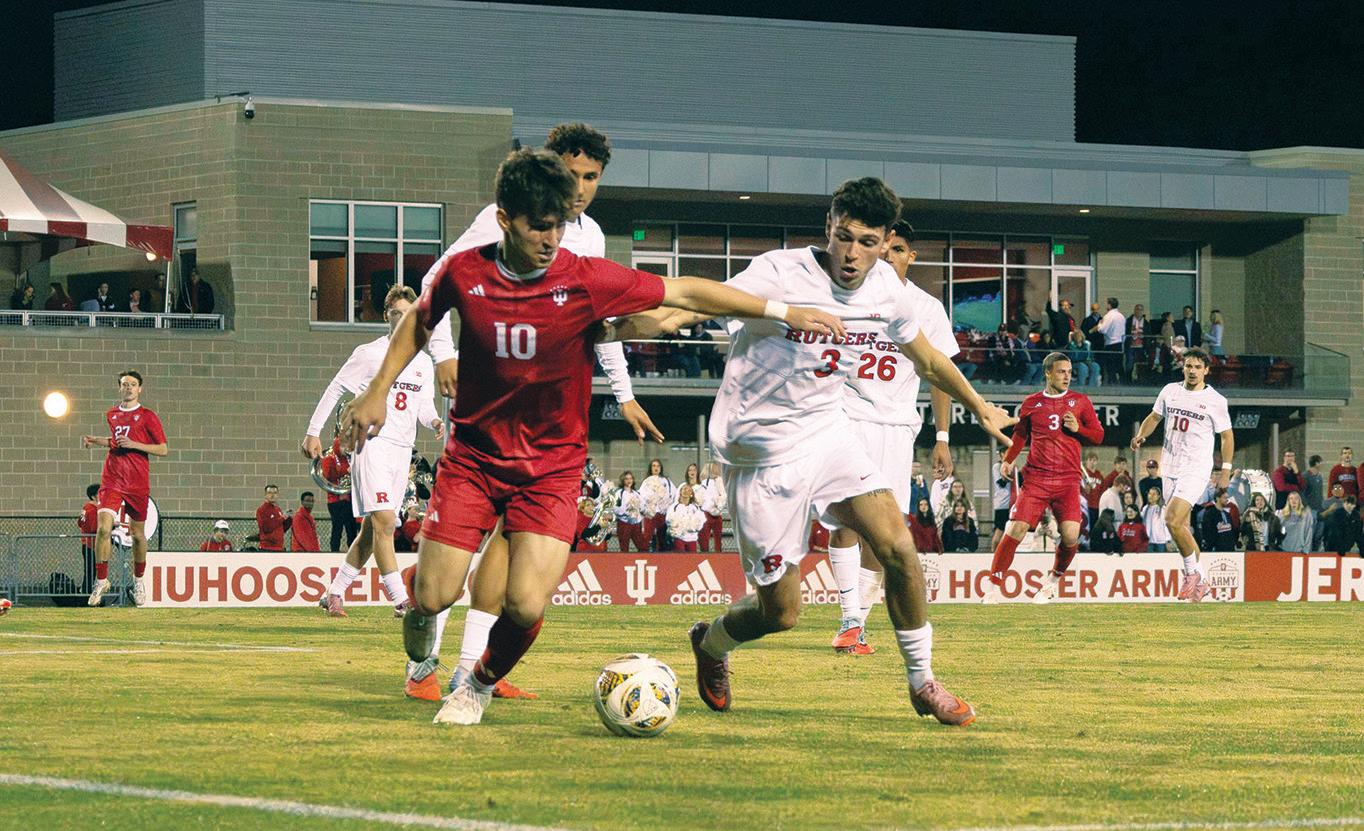
junior forward Clay Murador and redshirt junior defender Breckin Minzey each secured a goal. But with news of UCLA’s victory, the mood dampened around Bill Armstrong Stadium.
And yet, it may not be so bad for Indiana.
“We go to Maryland (in the Big Ten Tournament) and don’t get a result, we may not be any better off than we were not going,” Yeagley said. “Yeah, we could have gone there and won it and be a top four seed. Yeah, I think we could have been, but at the same time, I think we’re in a great spot.”
COLUMN: Nevaeh Caffey’s
By Sean McAvoy
semcavoy@iu.edu | @sean_mc07
Coming into the 2025-26 season, Indiana women’s basketball head coach Teri Moren had high expectations for freshman guard Nevaeh Caffey. Caffey has taken on an important role for the Hoosiers to begin the season. She has started and played over 30 minutes in both of Indiana’s first regular season games, proving to be a dominant force on the defensive end.
However, the transition to college basketball has proven difficult at times. Moren trusts her freshman in tough situations on the court, but from an offensive standpoint, Caffey has been underwhelming to start the season.
Caffey — a 5-foot-10 guard — has done more for Indiana than just scoring the ball. Her defense and aggressiveness were reasons why Moren believed Caffey could be a leader from game one and beyond.
“She’s a competitor, she’s relentless, she wants to win,” Moren said postgame Nov. 4 after an 80-46 win over Lipscomb University. “She’s super aggressive, offensively, defensively, sometimes too over-aggressive offensively, but we’ll help her with that.”
Caffey played 31 and 34
COLUMN:
By Kasey Watkins kaslwatk@iu.edu | @kaseywatki8773
CHICAGO — Just 42 seconds into the match against Marquette University, Indiana picked up its first foul of the game. Less than one minute later, with 18:35 remaining on the clock, the whistle blew again. Starting senior forward Reed Bailey committed the team’s second foul, forcing head coach Darian DeVries to pull senior forward Sam Alexis from the bench less than two minutes into action. The fouls didn’t stop there though. Another Indiana foul with 17:03 remaining. And again with 16:51 remaining. And again with 16:43 remaining. Midway through the first half, Indiana had already accumulated 10 team fouls to put Marquette in the double bonus.
minutes in Indiana’s first two regular season games for Indiana to start the season. But shooting at a 31.3% mark isn’t what the coaching staff wants to see. She missed four close shots during Nov. 7’s comeback 72-56 win over the University of Illinois Chicago and finished the game 2-of-7 from the field with only 5 points.
Reading college-level defenses has not been difficult for Caffey, as she finished with five assists against UIC. The trouble on Nov. 7 came in the form of her being too aggressive around the basket, something that Moren also noticed.
“If Neveah’s gonna continue to try to be aggressive at the rim, she’s gonna have to learn how to make contact with her defender and get herself to the free throw line,” Moren said postgame. “Somehow she has to be rewarded.”
Caffey started the game 0-of-4 from the field in the first half. She had bad misses, including hitting the front rim on a layup attempt from the middle of the paint in the first quarter and airballing a contested driving attempt in the second frame.
In addition to her poor shooting start, Caffey missed both attempts from the charity stripe Nov. 7 and only attempted four
It’s rest and recovery for the Hoosiers now. Murador netted a finish Nov. 7, his second of the season, but he was “a little banged up.”
Sophomore midfielder Charlie Heuer is slowly returning to form with six straight appearances after missing most of the early part of the season.
Not having a game Nov. 12 affords Indiana that luxury, Yeagley noted. It also allows him to be more detailed in his preparation, without the necessity of planning for an opponent five days away.
“So, our game experience — we have it,” Yeagley
WOMEN’S BASKETBALL
said. “Now, it’s can we just fine tune some of the parts of our game? And that’s where the extra training and being fresh and in a controlled environment, not traveling, all those things can be somewhat of an advantage.”
Indiana’s future is unclear until Nov. 17, when the selection committee makes its decision on the NCAA Tournament bracket. Yeagley believes his side is in a great spot — the Hoosiers are a top 16 seed in his eyes, whether it’s because of their No. 9 ranking in the RPI, their strong strength of schedule or their undefeated
nonconference record. But regardless of what the future holds, Yeagley and his squad know what the expectation is. The locker room was upset postgame, the head coach said, but it was also “confident” and “feeling good.”
Ault and his teammates believe they’re one of the best teams in the nation. The expectation of IU soccer is to win, he added. Those expectations come with eight national championship banners. From this point on, Ault and Indiana are playing each game for a ninth.
offense will come, but her defense already belongs
free throws through the first two games. Caffey’s offense will come in time and experience, but she’s already shown her value on the defensive side of the court.
Moren gave Caffey the assignment to defend UIC senior guard Jessica Carrothers. The 5-foot-7 Carrothers is coming off a season at Indiana University Northwest where she led all of the National Association of Intercollegiate Athletics in scoring with 31.4 points per game.
Caffey found it difficult to defend Carrothers’ unconventional jump shot in the first half. The Highland, Indiana, native started 7-of9 on her field goal attempts, but Caffey limited her to a 1-of-6 mark in the second half.
One possession that stood out from the rest was with 5:50 left in the third quarter and Indiana down 37-35. Caffey picked up Carrothers for all 94 feet. The Indiana defender stuck to the UIC ball handler like glue, leading to Caffey stripping Carrothers and forcing a shot clock violation.
Possessions like that are why Caffey has been inserted into the starting lineup.
“It’s not scoring the ball that keeps you on the floor for us,” Moren said postgame. “It’s guarding, defending, rebounding. That’s

what keeps you on the floor for us.”
Caffey will continue to start if she’s a plus defender for Indiana. Playing winning basketball isn’t something new for Caffey — while playing at Incarnate Word Academy in Missouri, she won 139 straight games to set a national record.
MEN’S BASKETBALL
However, Caffey will need to settle in on the offensive side of the court if she wants to turn into a great player at Indiana — something Moren believes will happen eventually.
It’s only the second game of the season, but the growth will have to happen sooner rather than later.
Indiana wants to return to the NCAA Tournament for the seventh consecutive season, and Caffey has the power to make or break that goal. “By the end of this,” Moren said postgame Tuesday, “she’s going to be one of the best guards to ever play here.”
Indiana dominates Marquette, must learn to defend without fouls The Hoosiers defeated the Golden Eagles 100-77 Nov. 9
The foul troubles throughout the night were masked by the Hoosiers’ overall performance in their dominant 100- 77 victory over the Golden Eagles on Nov. 9 inside the United Center in Chicago. However, the inability to play clean defense should raise concerns if not addressed. With the Hoosiers already lacking depth due to a plague of preseason injuries, losing more players to foul trouble limited the team to an even smaller rotation. While the effects of this weren’t evident against Marquette, it typically would be a critical factor in most games and against most opponents. In the first half alone, the Indiana starting five tallied nine personal fouls. Sixthyear senior guard Tayton Conerway picked up his third foul with 7:46 remain-
ing in the first half, limiting him to just eight minutes on the court in the half. Bailey picked up two early fouls while redshirt senior guard Conor Enright, redshirt senior forward Tucker DeVries and fifth-year senior guard Lamar Wilkerson added four more fouls combined. Bailey, who was limited to just three minutes in the first half, picked up his third foul 52 seconds into the second half, which sent him right back to bench. By the end of the game, Indiana had numerous players in foul trouble as Enright fouled out, Conerway and Tucker DeVries both had four fouls and Bailey and Alexis each had three.
Postgame, Darian DeVries said he wanted the team to continue to play with physicality while reducing its number of fouls.
“We need to do a better
job.” Darian DeVries said. “You know, we got a little handsy at times, and we got to clean that up.” He wants his team to continue being aggressive and to continue challenging the ball handlers with “a little less hand activity.”
Due to the accumulating fouls, Indiana was forced to continue making lineup changes. Luckily for the Hoosiers, the team adjusted to just about every lineup thrown at them and had many players step into new roles.
“I thought the guys just did a good job,” Darian DeVries said. “Their number got called, they got put in a position, and they were able to go in there and execute it.”
Indiana did plenty of good in its victory over the Golden Eagles, putting 100 points on a Shaka Smart-
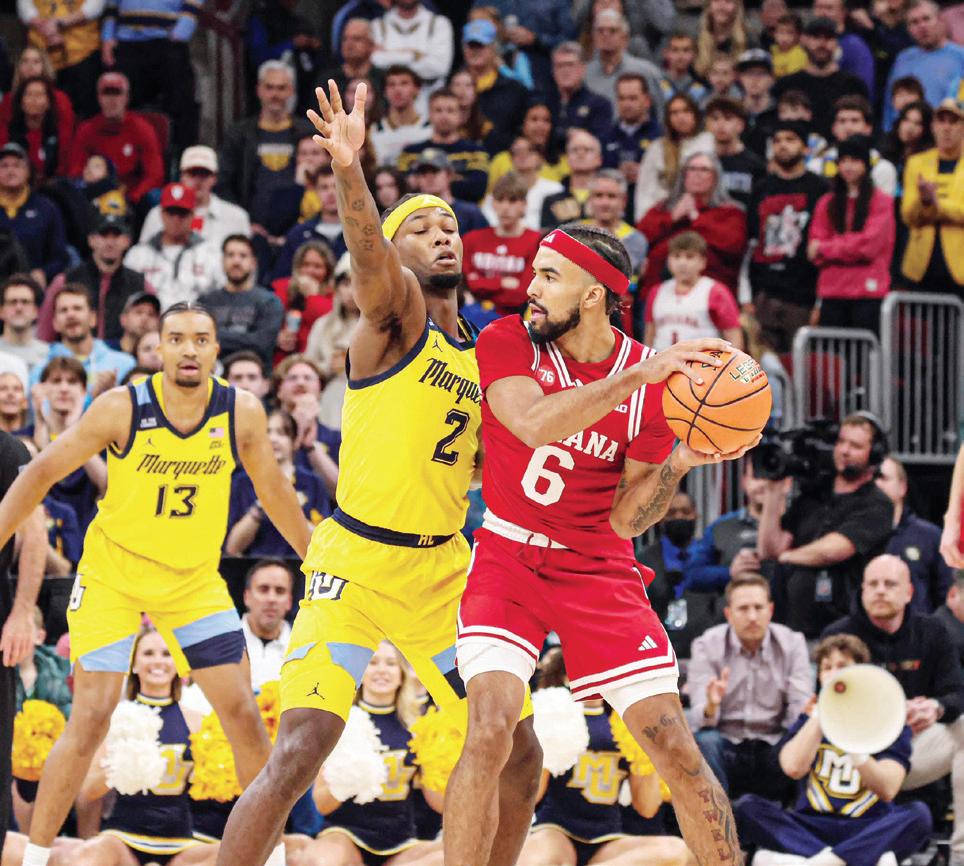







Indiana football wins at Penn State

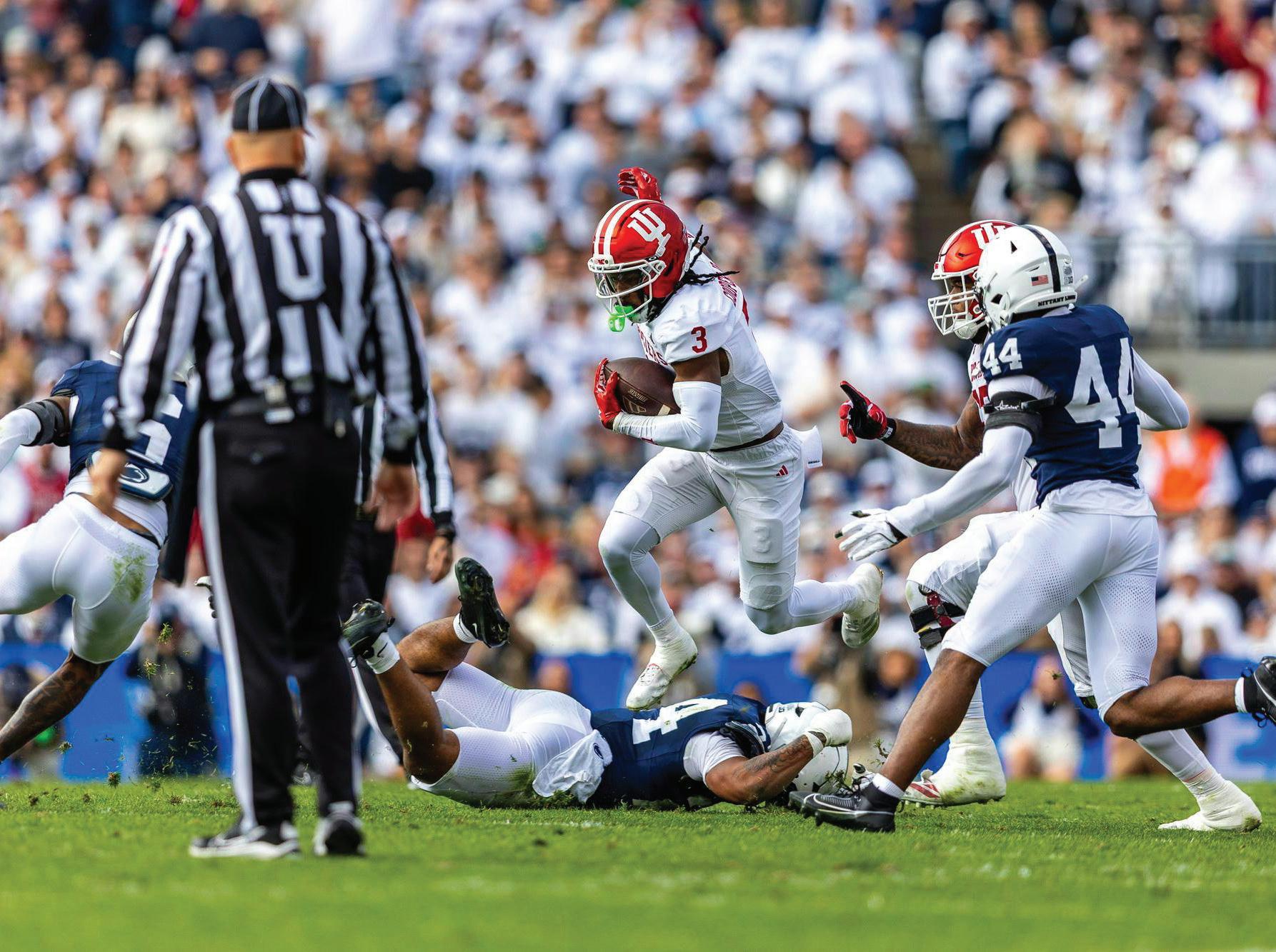
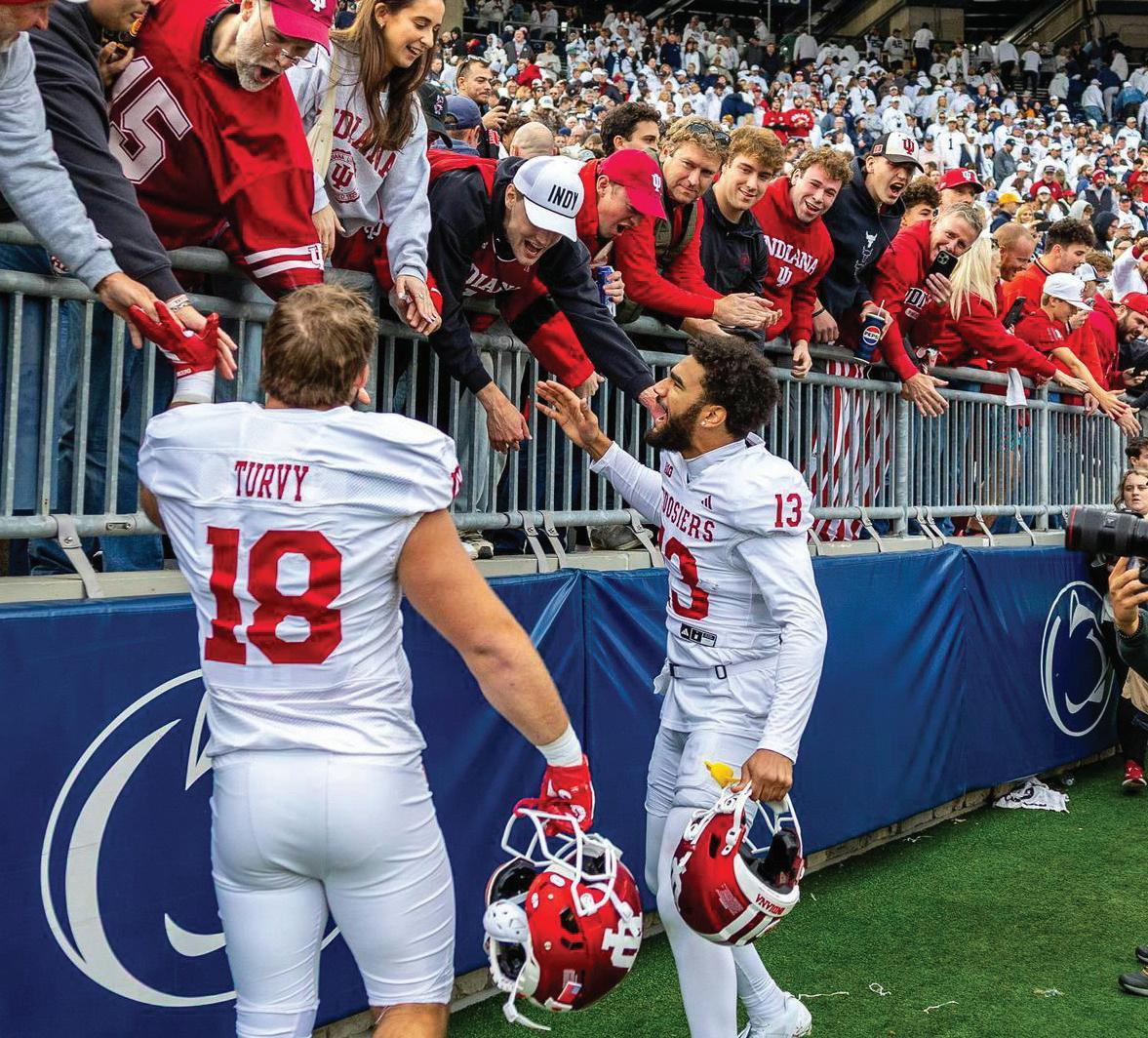
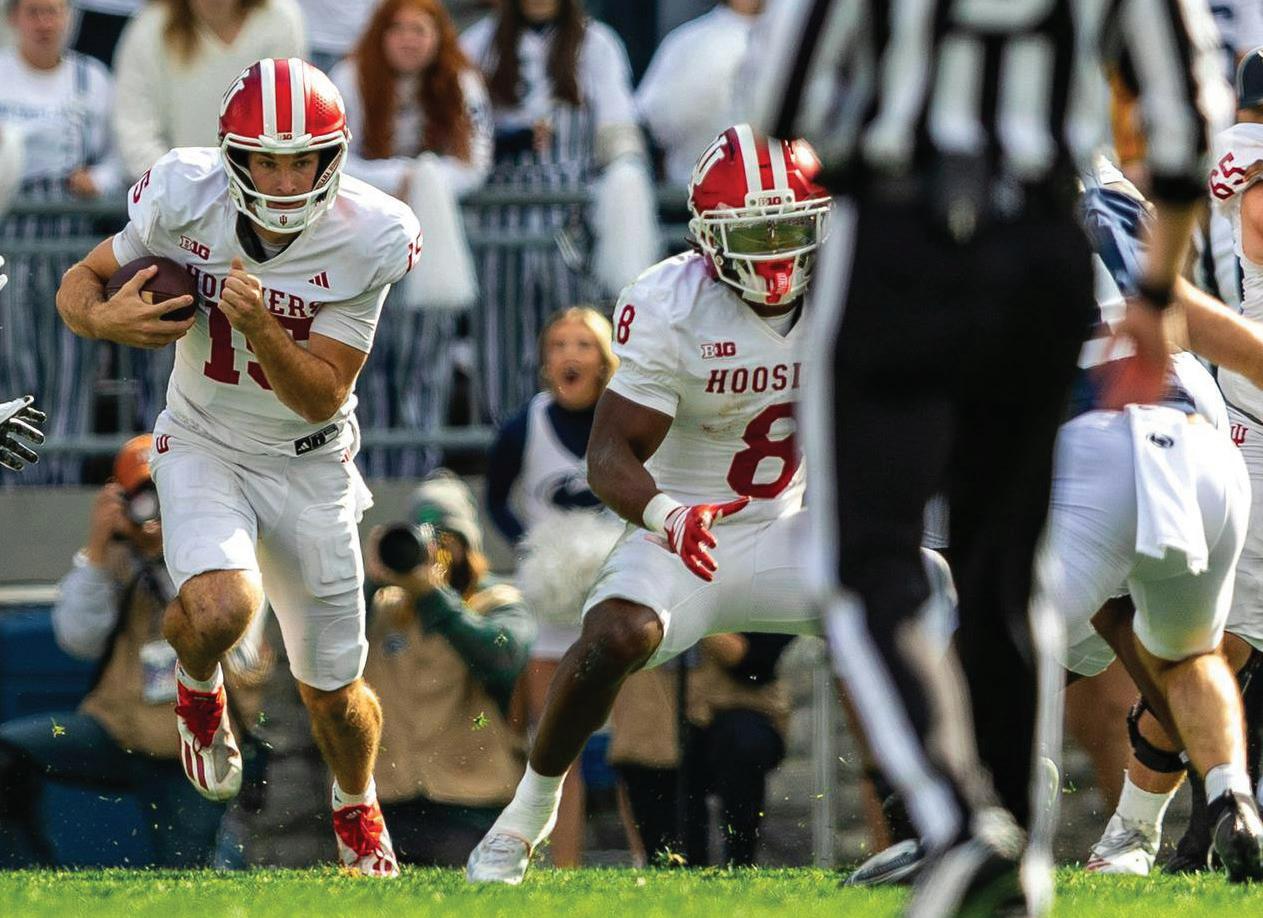
1 2 3 4 5 6
